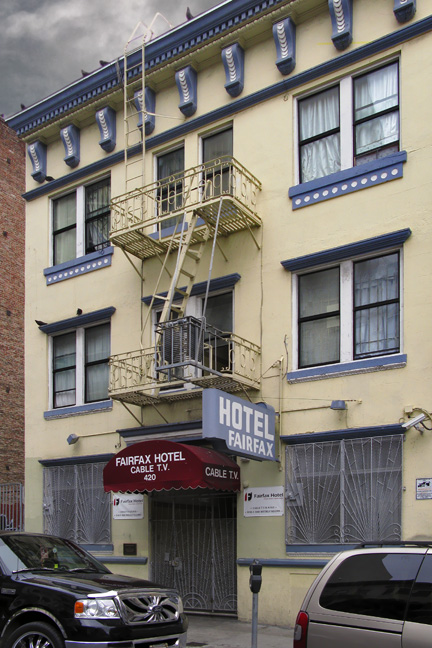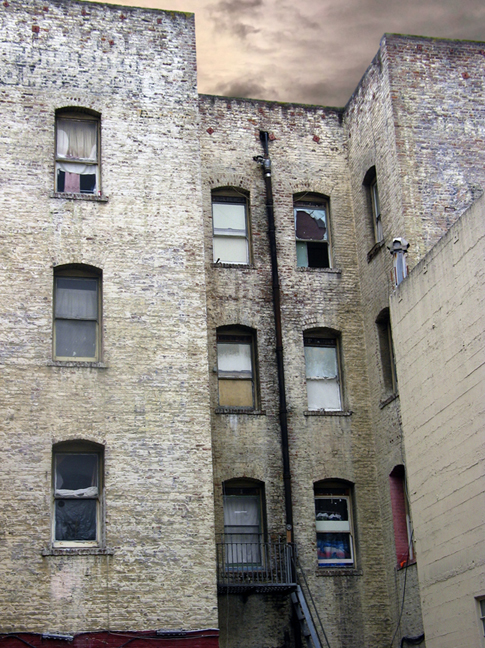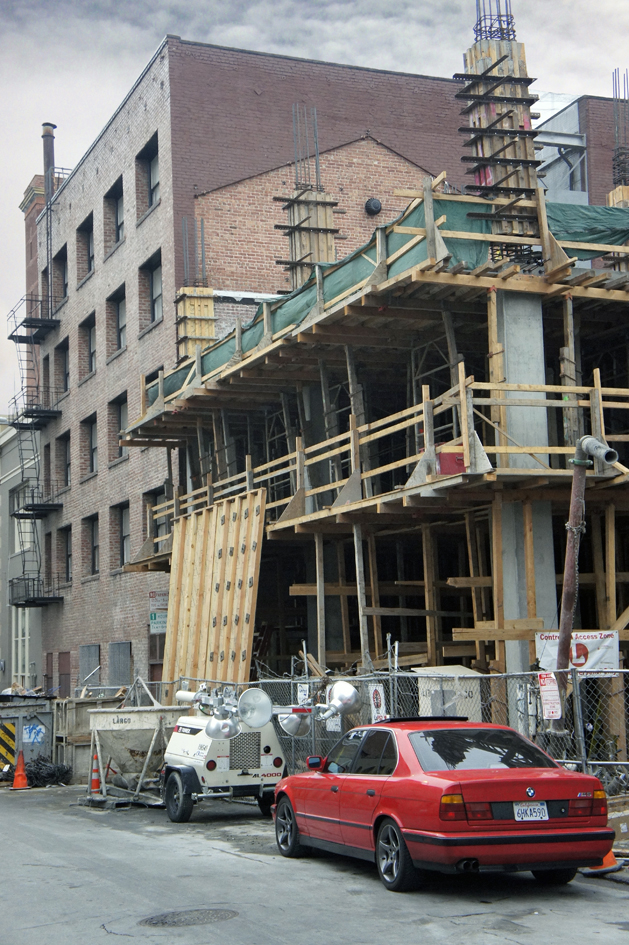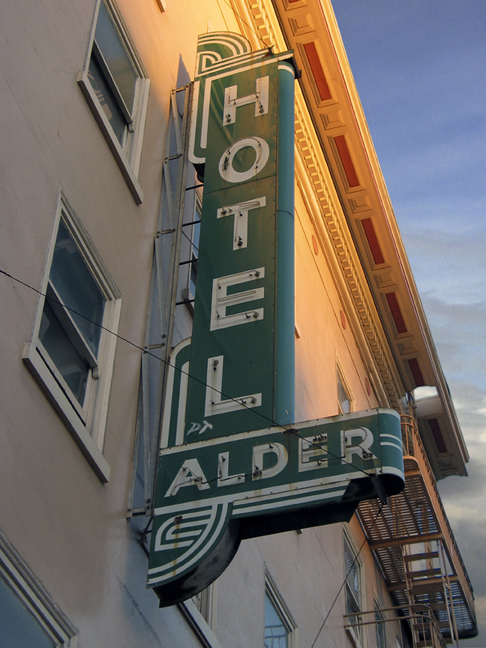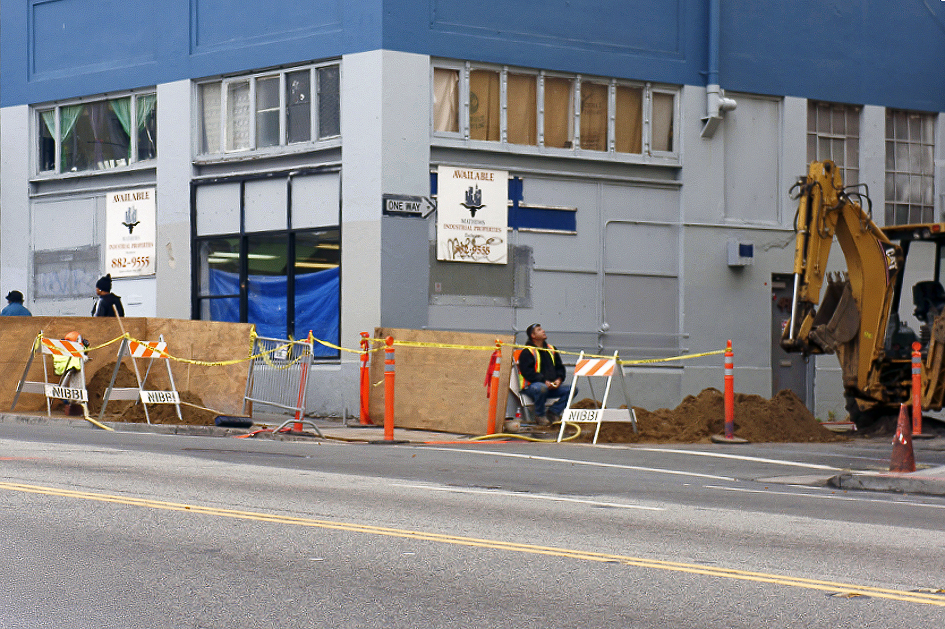Sixth Street
UPDATED 23 FEB 2014
Convergent Histories

Source: Bancroft Library, UC Berkeley
Sixth and Minna, 18 April 1906.
After the earthquake and fire of 1906, San Francisco’s Sixth Street was rebuilt with rooming houses and residential hotels — also known as SROs, or single room occupancy hotels — that for many decades housed the working class. These days, Sixth Street is where the poor are warehoused and the neighborhood’s working class origins are largely forgotten. As poverty is for many people an uncomfortable truth to be avoided, there are prejudicial blind spots in the general consensus regarding Sixth Street. In fact, most people wish Sixth Street would just go away.
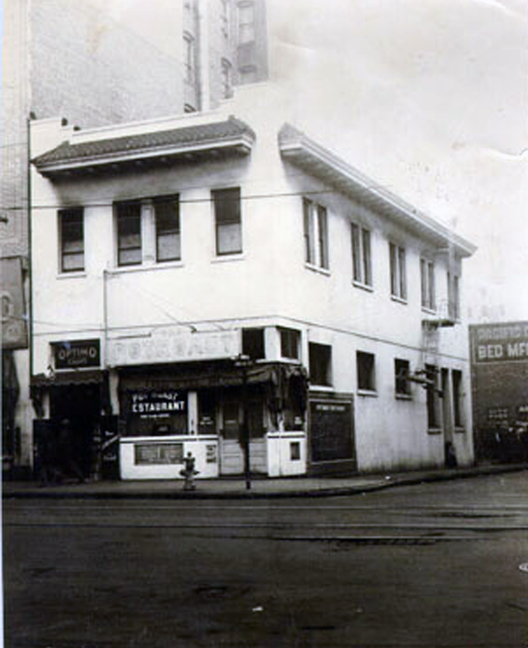
Source: San Francisco History Center, SF Public Library
Pot Roast Restaurant, 1927. Long-ago demolished, the Pot Roast was a Prohibition era speakeasy on the corner of Sixth and Jessie, next to the Hillsdale Hotel.
Daily life on Sixth Street has been documented since 1992 by the staff and students of the Sixth Street Photography Workshop and some moving portraits of neighborhood residents comprise a chapter of the book Many Voices by documentary photographer Virginia Allyn.* I began my own portrait of Sixth Street by documenting its architecture and signs. By getting involved in the neighborhood, I got to know the people who live and work there. By listening to their stories, I learned some history. I got involved with the neighborhood by living in it.
*2005, Trafford Books.
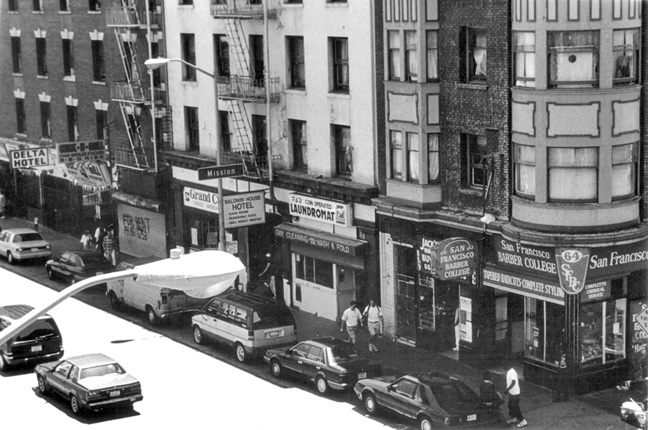
Sixth and Jessie, 1995. On the right is the Shree Ganeshai Hotel and in the upper right corner are the three turret windows to my old room, #10. (Photo by Virginia Allyn.)
In mid-Spring 2001, I felt like the luckiest man alive when, with little more than the clothes on my back and a 690 dollar monthly income from State Disability Insurance (SDI), I moved into the Shree Ganeshai Hotel on the corner of Sixth and Jessie. From the moment I became a tenant until the day I moved out, that hotel was home, my sanctum; the world wherein I reinvented myself and the fundament in which Up From The Deep was sprouted. The seed was a cheap digital camera that I rescued from the trash.

“Conveniently Located” (2004)
Midtown Loans. 39 Sixth Street.
Whitaker Hotel. 41 Sixth Street.
When I immigrated to San Francisco in 1968, the South of Market area was a poor, working class neighborhood largely populated by laborers, off-season migrant workers, merchant marines, and retirees eking out their golden years on meager pensions; men whose sweat and toil helped make San Francisco a thriving, prosperous, world-renowned city. I soon discovered that most people thought of these men as bums and winos, characterizations that had been cultivated since the mid-50s by the San Francisco Redevelopment Agency and downtown developers, instigated by hotelier and real estate mogul Ben Swig and promulgated by the San Francisco Chronicle and San Francisco News Call-Bulletin, two of the City’s daily newspapers.
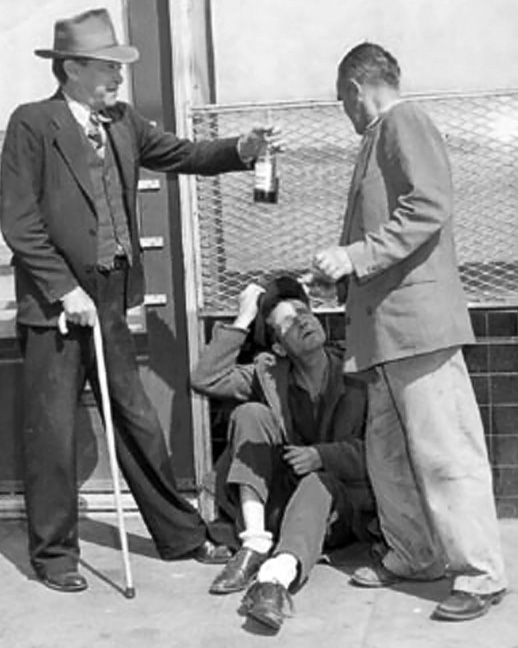
Source: San Francisco History Center, SF Public Library
Newscopy: “Alcoholics on Skid Road.” (SF News Call-Bulletin photo, 1956.)
Following World War Two, the densest concentration of South of Market SROs was in the area known as Yerba Buena, just across Market Street from San Francisco’s business and shopping district. To Ben Swig, Yerba Buena was prime real estate for the expansion of commercial and civic functions. Realizing that the most expeditious way of clearing the area would be to have it declared blighted, he donated money to the redevelopment agency in 1954 for the preparation of a study. Even though the money was returned by agency director and future mayor Joseph Alioto, the plan moved forward.
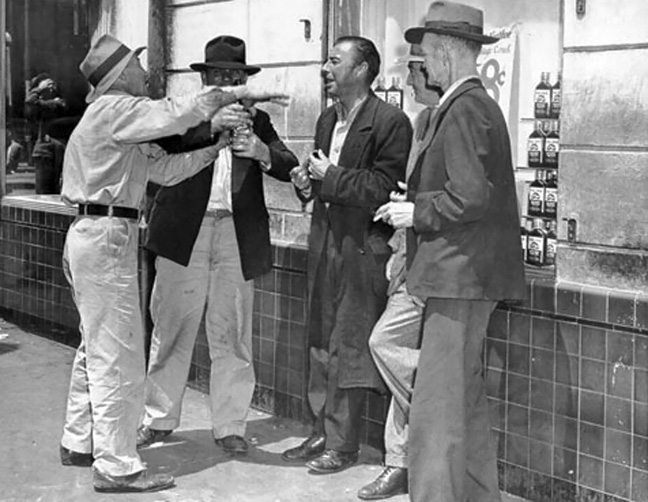
Source: San Francisco History Center, SF Public Library
Newscopy: “Men gathered on Skid Road.” (SF News Call-Bulletin photo, 1956.) Look closely at the faces and attire of the men in this photograph and you will see that these same gentlemen were also posed in the next photo.
In a campaign to discredit the neighborhood’s residents, the newspapers published articles that depicted South of Market SROs as flophouses inhabited by alcoholics and lowlifes, embellishing the stories by posing unwitting hotel residents in photos that purported to show them getting drunk on the sidewalks.
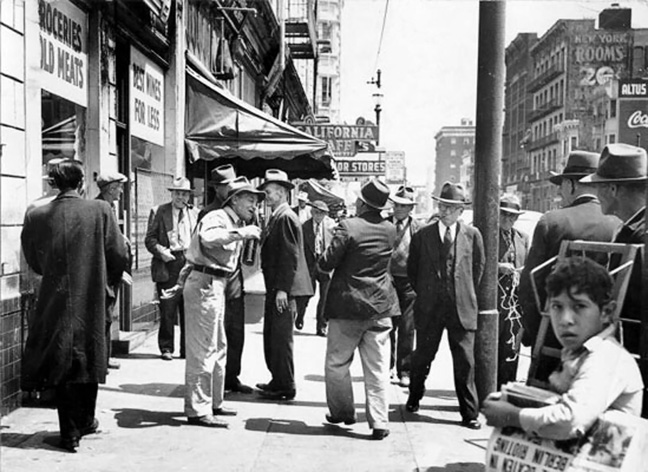
Source: San Francisco History Center, SF Public Library
Newscopy: “SKID ROAD, SAN FRANCISCO–‘No one along Skid Road is likely to shop carefully.’” (SF News Call-Bulletin photo, 1956.)
Little mention was made of the workers and retirees who were by far the majority of SRO residents. The intention was to mitigate concern for the thousands of people who were to be displaced by the razing of every SRO from Third Street to Fifth Street, thus allowing the City to save millions of dollars by sidestepping the issue of relocation. Who would care about the evictions of bums and ne’er-do-wells?
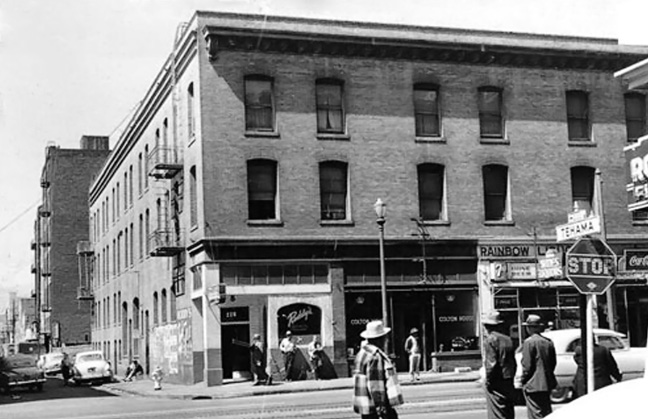
Source: San Francisco History Center, SF Public Library
Newscopy: “SKID ROAD–This is a hotel in the wino district. It has 200 rooms renting from 50 to 75¢ a night, chiefly to old-age pensioners.” (SF News Call-Bulletin photo, 1954.)
In 1969, many of those who would be affected joined together to form Tenants and Owners in Opposition to Redevelopment (TOOR), which took the City to court. After a grim and protracted battle during which people were killed, buildings burned, and political organizations suppressed, the City was forced to provide a modicum of relocation support and to build a couple of residential facilities for seniors before the area was completely gutted. Be that as it may, the cynical manipulation of public opinion successfully engendered a prejudice against hotel life that to this day shapes the common perception of Sixth Street.
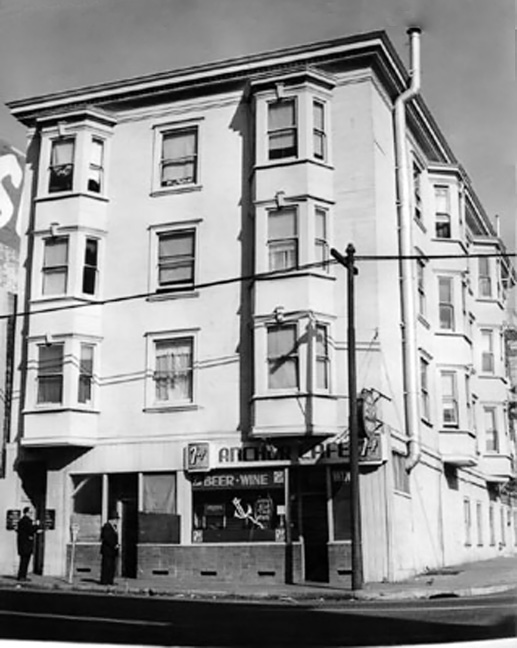
Source: San Francisco History Center, SF Public Library
Newscopy: “Slum area hotel at 259 Sixth St., owned by William H. H. Davis, president of the City Board of Permit Appeals.” (SF News Call-Bulletin photo by Sid Tate, 1961.)
In recent years a sympathetic district supervisor helped to implement some needed improvements for the SROs that remain, but otherwise the policies of city government and law enforcement have created more problems than they have solved. As if filthy sidewalks and poorly maintained hotels with greedy owners and abusive managers were not bad enough, residents must also live with the continual threats of robbery and violence, because the police for years have used Sixth Street as a containment zone for crime. The corralling of criminal activity by the San Francisco Police Department and irregular, substandard maintenance by the Department of Public Works are underlying reasons why attempts to improve the appearance of the neighborhood never seem to make any lasting difference.
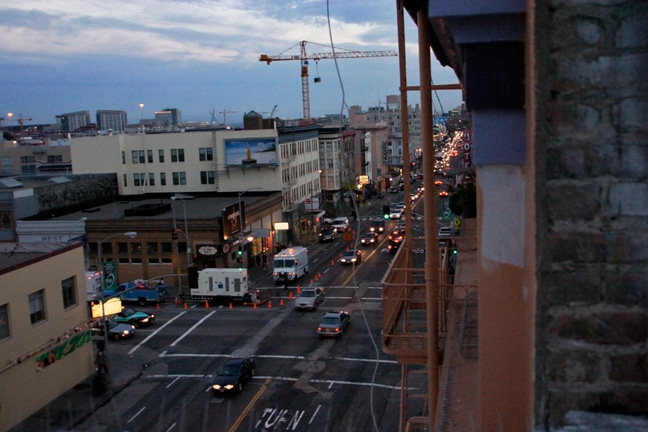
“Winter Evening – Sixth Street” (2004)
Vantage point: Shree Ganeshai Hotel. 68 Sixth Street.
Hotels that have been bought and refurbished by nonprofit housing corporations now have modern, better-maintained accommodations, a major improvement to be sure; but a system of tiered management tends to circumvent meaningful dialog with tenants who have valid complaints, and so-called supportive housing too often fails the very tenants who are least able to care for themselves. Ideally, supportive housing helps people with disabilities live independently by providing individualized services, including medical and psychiatric care, medication and appointment reminders, in-home healthcare assistance, addiction treatment, housekeeping, meal programs, and life coaching. In reality, what some nonprofits call supportive housing is little more than an administrative hierarchy of case managers who refer tenants to outside government and nonprofit service providers. Overwhelmed by sheer numbers and often lacking professional training and experience, such case managers have little time to spend with individual clients. Without on-site personal assistance and followup, some disabled tenants fall through the cracks. Unable to navigate their problems by themselves, they wind up in institutions or on the streets again.
Then there are the City’s master lease hotels, where crimes committed by staff and management — including embezzlement, drug dealing, property theft, pandering, rape and other forms of violent assault — are disturbingly pervasive yet receive little public attention, largely because victims are persuaded to settle out of court. Prominent among master lease hotels is the Seneca on Sixth Street, notorious for violence and open drug activity in the hallways.
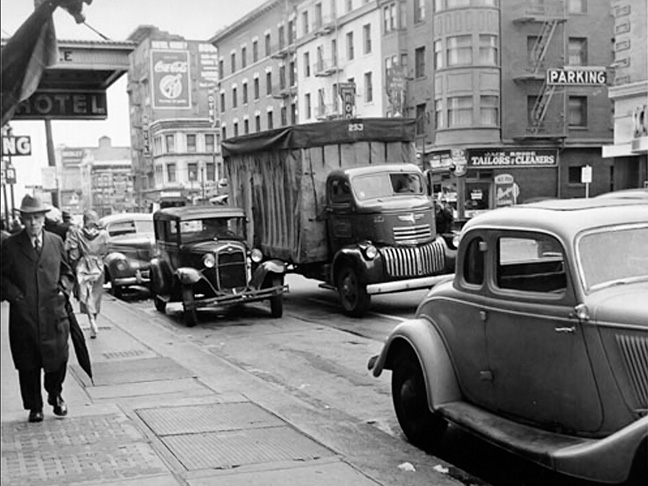
Source: San Francisco History Center, SF Public Library
Sixth Street, circa 1950.
I have great love for Sixth Street, not for what it has become, but for what lies beneath the veneer of crime and decay, invisible to all except those who live and work there: its people and its history. Much of what I have learned comes from the stories of old-timers who have lived and worked on Sixth Street for many years. I also have the experience of living in a Sixth Street hotel for nearly six years, and personal memories that span the years since my landing in San Francisco. In all the extensive Bay Area photo archives, there are decidedly few historical images of Sixth Street, but my own photography will some day add a bit more to the record. Even though my portrait of Sixth Street is largely an expression of love, it is also an act of defiance whereby I call down the despoilers of individual lives and thumb my nose at the relentlessly onrushing forces of urbanization and redevelopment, which have no use for history.

“Sai” (2003)
Sai Hotel. 964 Howard Street.
Near the middle of February 2001 — one week out of the hospital and just beginning to recover from a six year nightmare of homelessness and heroin addiction — I rented lodgings at the Sai Hotel for 400 dollars a month.* As this was well below what other SROs were charging, it seemed like a bargain until I actually saw what I had rented. On the top floor at the back of the building, an undersized door opened inward on a room so absurdly small, it barely qualified as a crib. The bit of floorspace unoccupied by a single-width bed was a narrow strip along the length of the room, but this was mostly taken up by a small sink and a nightstand. All that remained empty was clearance for the door. To open or close the door from inside the room, I had no choice but to stand on the bed. Every time I shaved or washed my face, I risked electrocution by the ungrounded electrical outlet in an open utility box over the sink. For all practical purposes inaccessible, the lead-colored walls were entirely bare. A diminutive window above the nightstand provided meager illumination that barely dispelled the gloom. Suspended by a length of ancient cloth-insulated wire, a naked sixty-watt light bulb offered more light, but I rarely used it as the glare was intolerable. Every aspect of the room was uncomfortable and oppressive. It felt like a broom closet, in fact I think it had been one, but it was the first place I could call home after nearly six years on the streets.
*cf. Personal History.
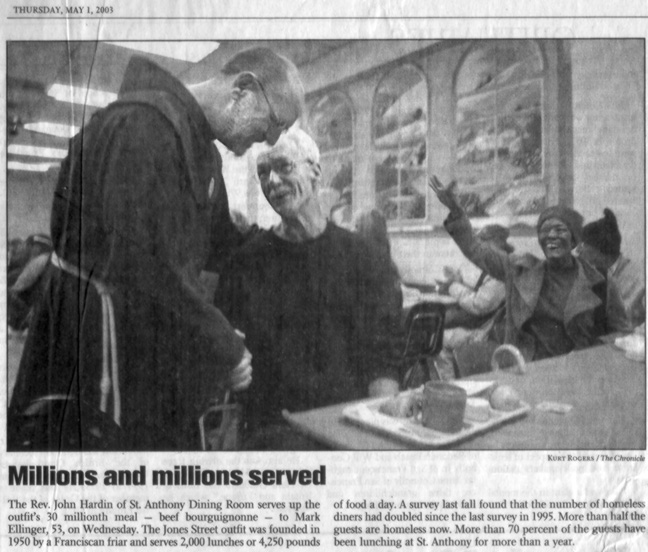
San Francisco Chronicle, 01 May 2003. Surviving on 690 dollars a month was a constant struggle. For a long time, my one daily meal was lunch at St. Anthony’s Dining Room.
Even though I was grateful to have it, my room was far too cheerless and confining to be more than a place to rest my head, so I spent very little time actually living at the Sai. It would be many months before my surgical wounds were more or less healed. Between thrice-weekly visits to the hospital wound clinic, I occupied much of my time reading and writing at the Main Public Library on Grove Street. Lunch at St. Anthony’s Dining Room was my daily bread. An acquaintance one day introduced me to his friend Jozsef, who invited us to tea in his room at the Shree Ganeshai Hotel. Jozsef was an artisan and house-painter who had fled from Hungary during the turmoil of 1989. We discovered in each other common sympathies shaped by hardship and our dialog filled a mutual need for intellectual stimulation. I was soon enjoying regular visits to Jozsef’s snug and homey room, where he had been living for several years. The Shree Ganeshai Hotel was small, quiet and affordable,* and management rented only to long-term tenants. It seemed ideal, and with Jozsef’s endorsement, the manager agreed to let me rent the next available room. I could only hope it would be soon.
*Monthly rent would be 520 dollars, leaving me 170 dollars on which to live.
“Fairfax” (2011)
Hotel Fairfax. 420 Eddy Street.
Having lived a month in a dismal crib at the Sai, I was more than ready for a change, but the only vacancy I could find was a room at the Hotel Fairfax, a haven for heroin-addicted hustlers, prostitutes and crackheads. Peace and quiet were the rarest of commodities at the Fairfax. Management rarely ventured beyond their first-floor enclave, and hotel housekeeping was spotty and superficial at best. The upstairs bathrooms and toilets were unspeakably vile. For the most part, tenants were free to carry on however they pleased in shadowy hallways and on dark, winding stairs at all hours of the day and night. In need of a temporary hideout or a bathroom, or for reasons best left undiscovered, all kinds of unsavory characters would lurk about the upper floors late at night after sneaking up the rear fire escape. In the end, five weeks at the Fairfax was all I could stand.

“Invocation” (2003)
Shree Ganeshai Hotel. 68 Sixth Street.
For the next few weeks, I slept sitting upright in bus shelters. At last in mid-May, I took possession of a room at the Shree Ganeshai. The title of the photo “Invocation” is derived from the name of the hotel. Many centuries ago, Sanskrit scholars began their writings with an invocation to God, usually the one their family worshiped. One such invocation, to Ganesha,* was shree ganeshaya namah. Over time the invocation came to be used before starting any activity and was gradually shortened until shree ganesh sufficed as a prayer for an auspicious beginning. The phrase is used today before any beginning, be it a meal, a journey, or a task. During my stay at the Shree Ganeshai, it was comforting to know that the name of my home was an endless prayer to Ganesha for a bright and beneficent new beginning. To this day I keep on my bookshelf a small golden effigy of Ganesha, a gift from the Shree Ganeshai’s manager, Nagin.
*In the Hindu pantheon, Ganesha is the elephant-headed god of wisdom and auspicious beginnings, who brought writing to the world by breaking off one of his tusks to use as a pen.
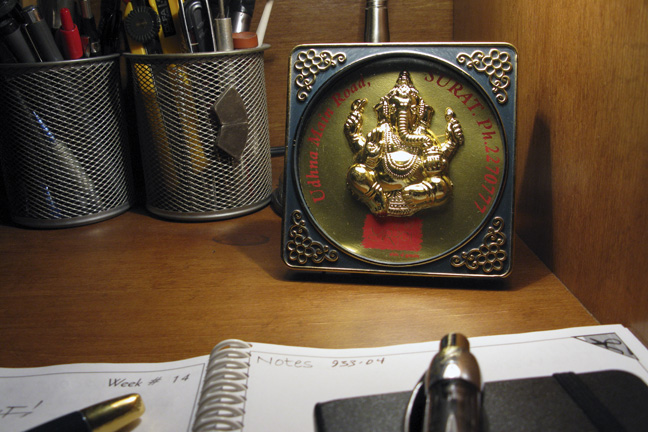
“Ganesha” (2010)
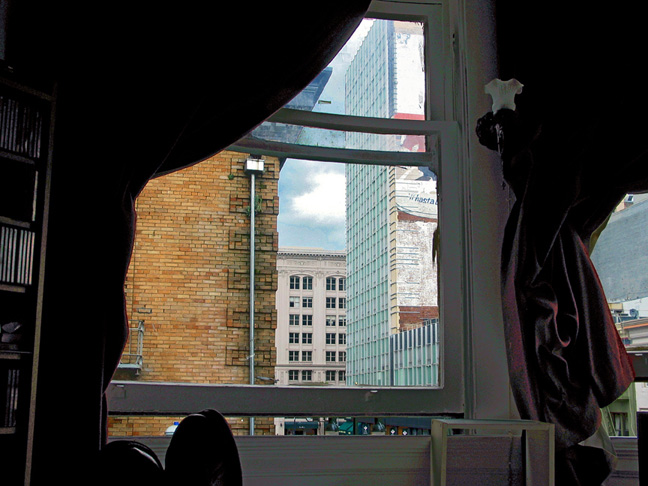
“A View from My Old Room” (2005)
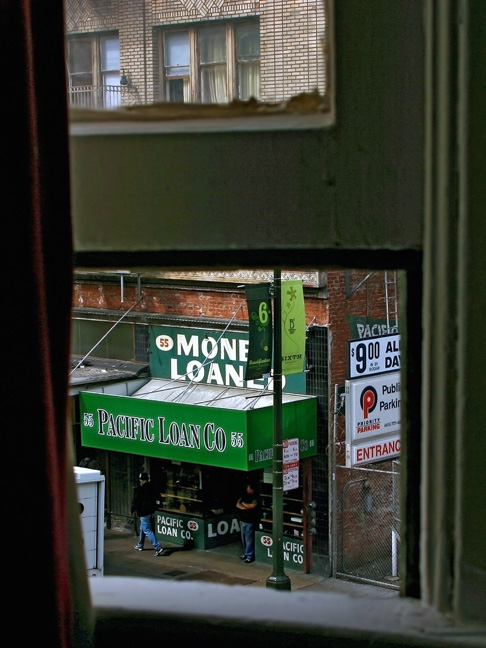
“A View from Room #10” (2006)
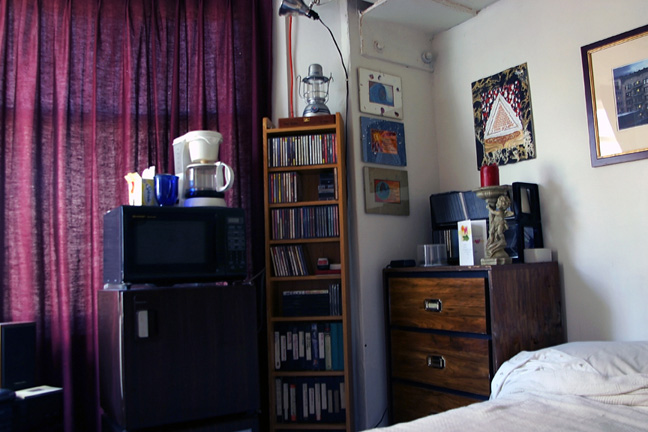
“A Corner of My Room” (2006)
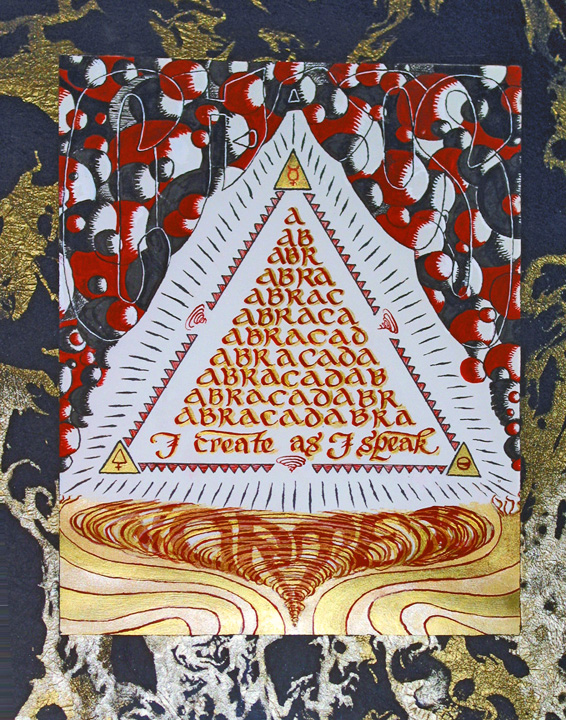
“abracadabra” (2001)
Reinventing myself meant foremost, rebuilding my sense of self by recovering memories of who I had been before life as a homeless junkie annihilated my self-image; that, and reactivating parts of my brain that had fallen dormant during that time. To accomplish this, I used writing, drawing, painting and calligraphy as my primary tools. Above is the first of my pen-and-ink drawings, dated July 2001, my third month at the Shree Ganeshai Hotel. While hospitalized, I had rediscovered my love of language and symbolism when I read Umberto Eco’s Foucault’s Pendulum. Soon afterward, I started a journal and sketchbook. Once I had established myself at the Shree Ganeshai, I began poring over alchemical treatises and ars combinatoria of the Middle Ages, wherein I found the inspiration for many of my drawings, including “abracadabra.” Below, dated November 2001, is the first of three watercolor decorated letters that paid homage to poets whose writings had inspired me in years gone by. Near the end of 2002, after acquiring a castoff plastic camera, I began photographing my surroundings.

“Alone” (2001) Stanza from The Rime of the Ancient Mariner by Samuel Taylor Coleridge
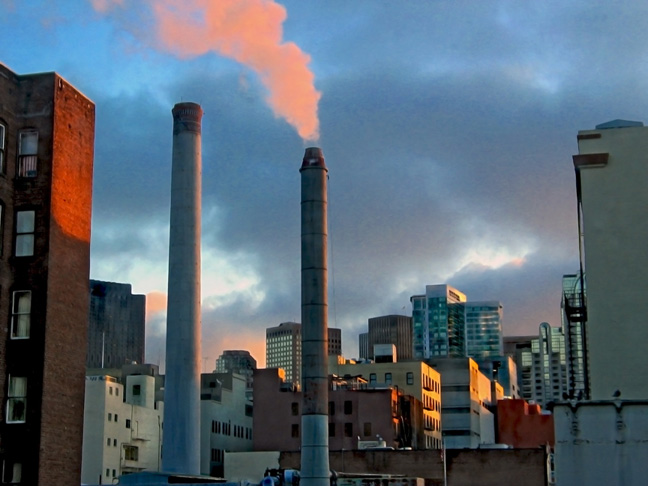
“Dawn – Rain’s End” (2005)
As an insomniac, I have seen many beautiful sunrises. I captured this one while seated at my computer one spring morning after a night of heavy rain. On the left is a corner of the Hillsdale Hotel. The stacks are part of a PG and E steam plant on Jessie Street. This particular view resonated very deeply with me, and the reasons for this are to be found in my childhood.
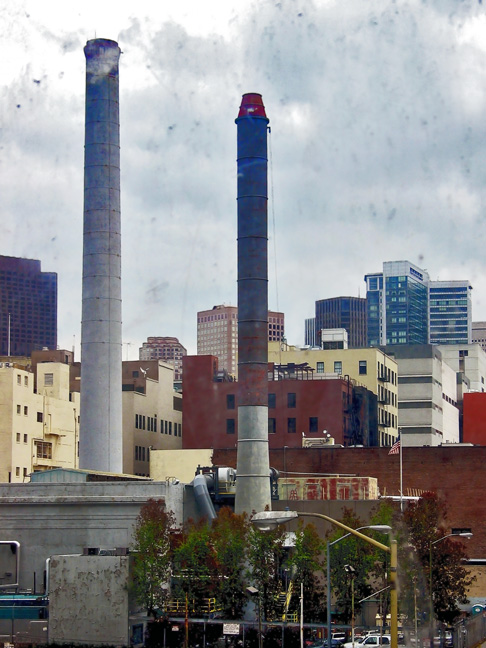
“Gray Day #3” (2005)
I grew up in a Midwestern city in the 1950s, before urban renewal, corporatism, and the “form follows function” aesthetic of postmodern and corporate modernist architecture eviscerated much of this country’s soul. Grandpa “PR” Ellinger was a brakeman for the B and O Railroad. Some of my earliest memories are of freight trains being assembled in the yards by 0-8-0 switching engines, and of giant 4-8-2 locomotives waiting by the pit or in the roundhouse. Everywhere were the smells of coal smoke, oil and hot metal, and the sounds of herculean iron machines at work: a crashing and hissing of superheated steam punctuated by whistle blasts that telegraphed the movements of the trains.

“Island Out of Time” (2004)
Hillsdale Hotel. 51 Sixth Street.
My other grandfather, “Red” Tobin, was a chemist for the city water purification plant, built circa 1912. When I was a boy, the plant’s enormous machinery, valves, pipes, filtration pools and conduits were still original, as were the many brass-handled controls and oversize gauges. Everything was perfectly maintained and housed in cavernous structures of iron and brick. All of this filled me with wonder and I idolized Grandpa Tobin, so at times when he had to check plant operations, I would beg him to take me along. Each time he would walk me throughout the enormous facility, patiently explaining everything in great detail. Most wondrous of all was the pump house, a brick building five stories high and three stories deep that had brass-railed ironwork galleries instead of floors, and walls that were lined with banks of indicator lights and old-fashioned recording gauges—all built around the colossal, steam-driven, Corliss flywheel pumps that fed the city’s water supply. Such are the archetypes that inform my world view.
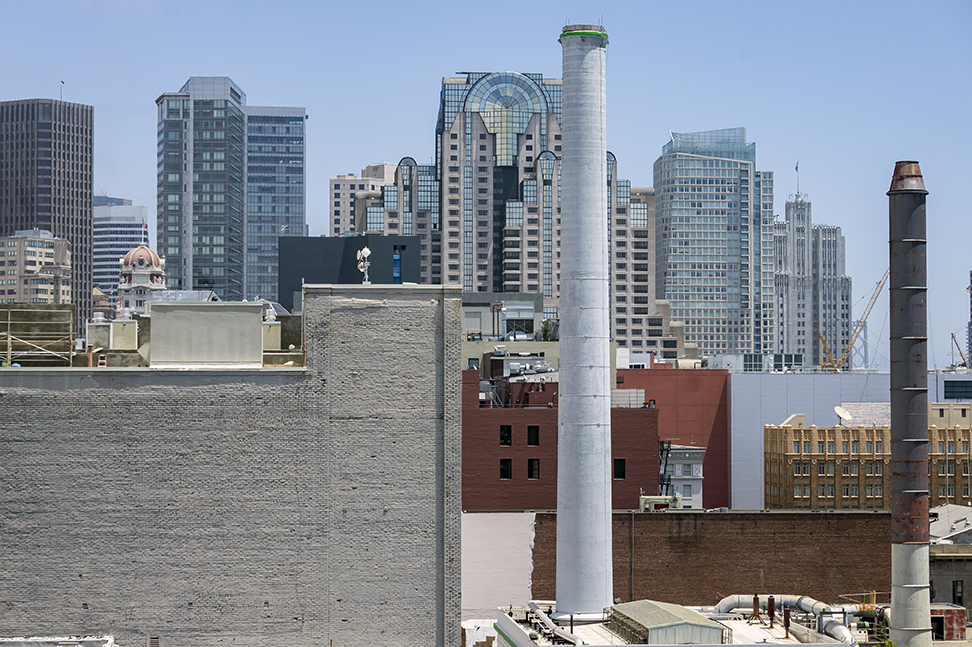
“Stacks” (2014)
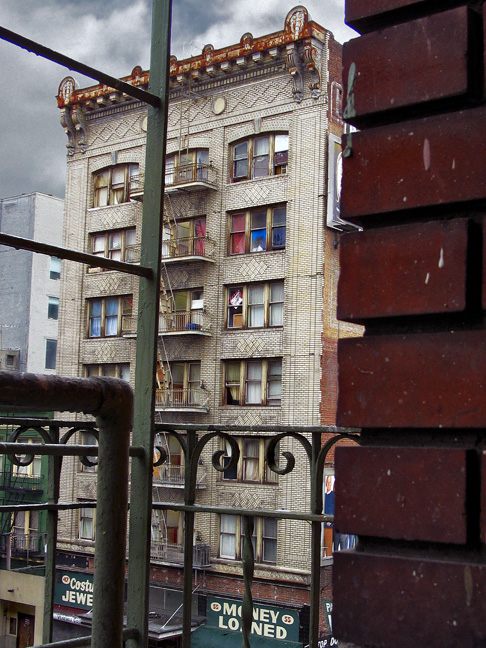
“Hillsdale” (2003)
It should therefore come as no surprise that I find poignant beauty in buildings most people regard as lowly, squalid eyesores. These old hotels have an archetypal quality that stirs my blood and attracts me like a magnet. So many people, so many stories, so much living has taken place within their walls. How can you not feel it? We are far too willing to dispose of anything that is old just because we are told that new things are somehow better. I would ask why we are being told this. Who benefits when we are divested of our history and culture?
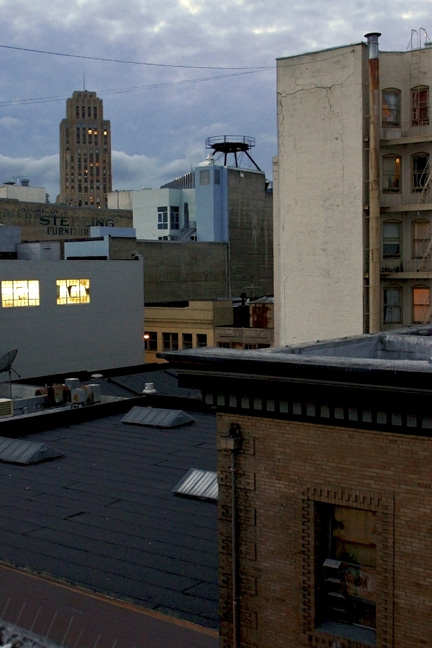
“My Back Yard” (2004)
The closest building in this photo is the Lawrence Hotel. Behind it is the Hotel Seneca, where windows to inner worlds glow as evening falls. The rear wall of Fascination can be seen peeking over the roof line of the Lawrence where it intersects with the edge of the Seneca. Between the Seneca and the McAllister Tower in the background is black-iron framework that once supported a water tank. Many of the older buildings in San Francisco have still-functioning rooftop water tanks, built in response to the 1906 conflagration that was catalyzed by earthquake-shattered water mains.
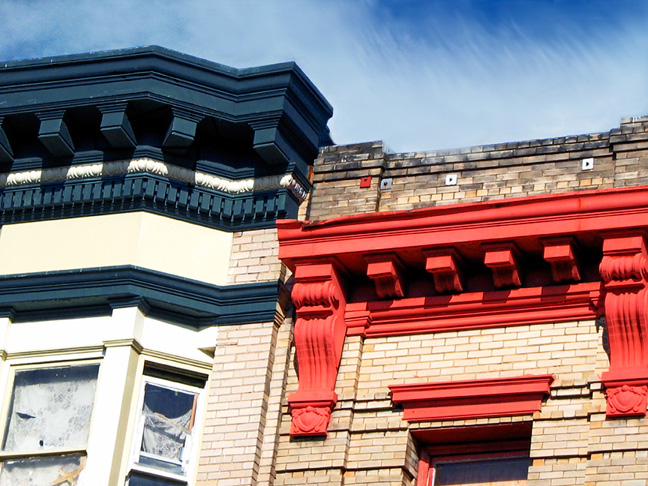
“Dentils of Metal” (2003)
Sunnyside Hotel. 135 Sixth Street.
Minna Lee Hotel. 149 Sixth Street.
In Classical architecture, the repeating, box-shaped components of a cornice are called dentils. While their size and details vary, they are always symmetrical and look like rows of evenly spaced teeth, whence their name was derived.

“A Lost Art” (2003)
Sunset Hotel. 161 Sixth Street.
Shown here is a small section of the cornice that crowns the Sunset Hotel. I like it for a number of reasons, not the least of which is the simplicity of its design. I also like the very large dentils and the medallion that decorates the bracket at the end. Rust reveals metal beneath the illusion of carved stone. Simplicity and neglect combine to make this architectural detail a perfect symbol for all old residential hotels.
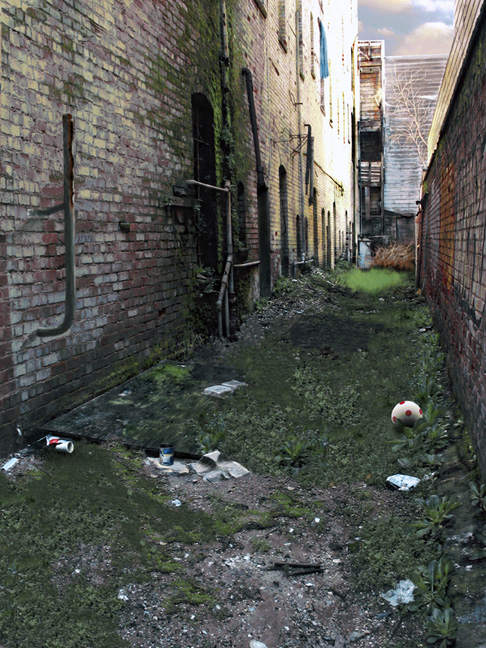
“If Walls Could Speak” (2003)
Hugo Hotel. 200 Sixth Street.
The Hugo was Sixth Street’s oldest hotel. Shuttered and vacant after a fire burned out several rooms in 1987, the unreinforced masonry building also suffered structural damage in the 1989 Loma Prieta earthquake. In 1997 a group of artists led by Brian Goggin transformed the Hugo into an immense sculptural mural called “Defenestration.” Scavenged furniture and appliances were modified by the artists to make them appear animate and then cleverly affixed to the hotel. Tables and chairs leapt from the roof and ran across the walls. Lamps corkscrewed from some windows, and sofas, refrigerators, bathtubs, even a grandfather clock squirmed and leapt from others. Sightseers took untold thousands of photographs of the Hugo and its famous furniture, a housing crisis turned into public art. I photographed the Hugo’s former service alley because it showed the only wall of the hotel that had not been altered, save by the hand of Time.
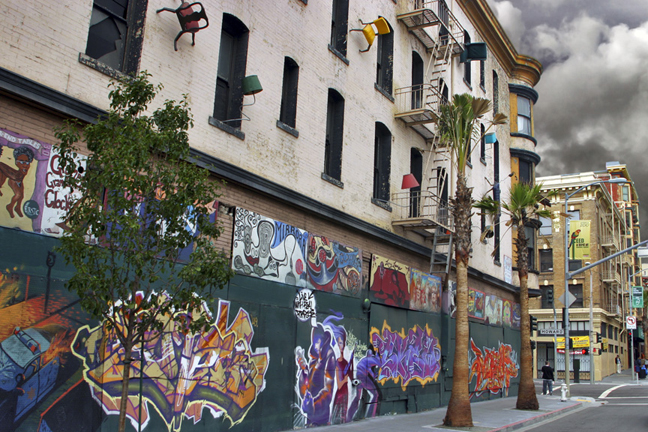
“Defenestration” (2005)
Hugo Hotel. 200 Sixth Street.
“Defenestration” endured for nearly eighteen years, although most of the original sideshow-themed paintings disappeared beneath eye-popping murals of polychrome street art. As a work of conceptual art, the Hugo Hotel was universally appealing — everyone liked it — and I grew more attached to it with each passing year. Yet few people know the hotel remained empty for almost thirty years because its owners cared more about profits than people. They refused to repair and maintain the building as low income housing, but were unable to sell it because their asking price vastly exceeded the building’s actual market value. Their outspoken contempt* for those less fortunate reflects an attitude that for years has been tacitly encouraged by the policies of local government. After years of haggling with the owners, in January 2008 the redevelopment agency announced it was seizing the Hugo by eminent domain, foredooming the controversial landmark to demolition.
*“They can put the low-income people somewhere else… you can be homeless somewhere in Idaho.” –Varsha Patel (former owner, Hugo Hotel)
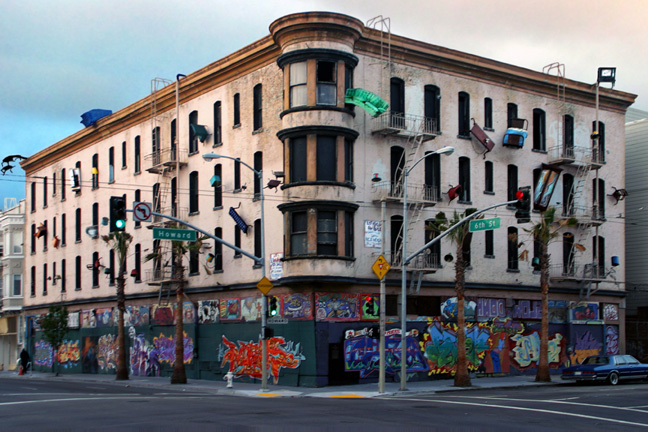
“Daybreak – Hugo Hotel” (2006)
Hugo Hotel. 200 Sixth Street.
As embodied by the new Yerba Buena pavilions, galleries, malls and tourist hotels, and a widespread proliferation of drab and overbearing condominiums, modern urbanism has been steadily taking over the South of Market landscape for several decades. Demolished, plowed under and built over, the old “South of the Slot” district has been fragmented into near-oblivion, and Sixth Street for years has been slowly dying by attrition. The Hugo Hotel was at last razed in mid-Spring 2015. Inasmuch as it helped prevent the total dissolution of the old neighborhood by holding off encroaching urbanization and gentrification, the transformation of Sixth Street will no doubt proceed in earnest now that the hotel is gone. Despite its longtime closure in the face of a housing shortage, the Hugo was given new life and purpose by the artists who created “Defenestration.” Transformed, the old hotel was a kind of signpost: a reminder of the past and a symbol of the present. It was a powerful presence that will not soon be forgotten.
Architecture and Signs

“Rainy Afternoon – Sixth and Natoma” (2003)
The building on the far left is the St. Cloud Hotel, a wood frame rooming house above a storefront occupied by the San Francisco Mission. Renamed City Team Ministries, it has been in continuous operation for over a hundred years, offering respite for the City’s dregs. The yellow building behind the St. Cloud is a wing of the Dudley Hotel, a renovated SRO that now operates as supportive housing. Beyond the Dudley, a row of flats is punctuated by a century-old brick stable.

“Legacy” (2003)
447 Minna Street (rear).
There are still places South of Market, mostly on narrow back streets between the main thoroughfares, where the buildings have stood virtually unchanged for a century; remnants of a vibrant past, survivors of the slash and burn strategies of urban renewal.
“447 Minna” (2013)
“447 Minna Street” (2013)
I am especially fond of this building’s crow-stepped gable, early examples of which can be found in the architecture of Germany and Denmark, from the fifteenth century onward.
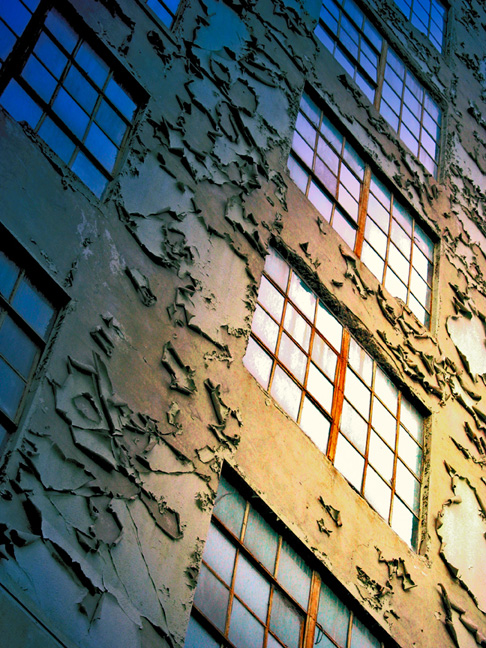
“Peeling Wall” (2003)
Abandoned Fire Station. Jessie and Mint.
When the City closed down its Jessie Street fire station, the building was left empty and unmaintained for so long, its sunburned facade began to look like something organic and alive. After I photographed it, the building was transformed into upscale lofts by the Martin Building Company. In memory of the old wall, a large print of this photograph now hangs in their main offices, a reminder of a small piece of history that would otherwise be forgotten.
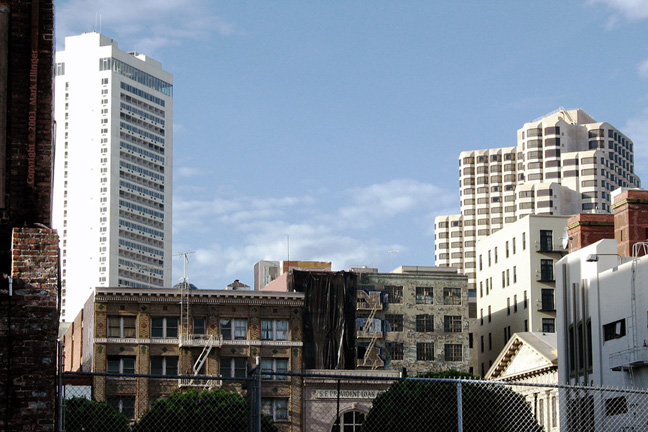
“Skyline” (2003)
Looking north from Natoma near its intersection with Mary, one sees from left to right the rear of 447 Minna, the San Francisco Hilton Tower I, the Chronicle Hotel, The Provident Loan Company, the Old Mint’s west pediment and its red-brick chimneys peering over the roof line of the Chronicle Newspaper Building. Behind the Provident are the unfinished offices of the Martin Building Company, the disused Jessie Street fire station, and condos over-topped by the enormous Parc Wyndham Hotel in the background.
“Mary Street” (2013)
Chronicle Hotel. 936 Mission Street.
San Francisco Provident. 932 Mission Street.
Opened 12 December 1912 as the San Francisco Remedial Loan Association, San Francisco Provident still stands in its original landmark setting, next to the Chronicle Hotel.
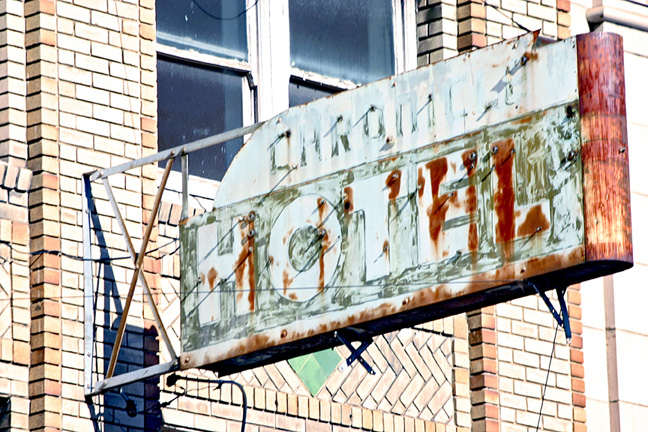
“Chronicle” (2006)
Chronicle Hotel. 936 Mission Street.
As the long-empty Chronicle Hotel has languished into uselessness, its blade sign has rusted and faded into cryptic hieroglyphics.
“Arbor” (2012)
Across Mission Street from the Chronicle Hotel, the sinuous branches of old ficus trees have overspread the sidewalk to form a shady alcove.
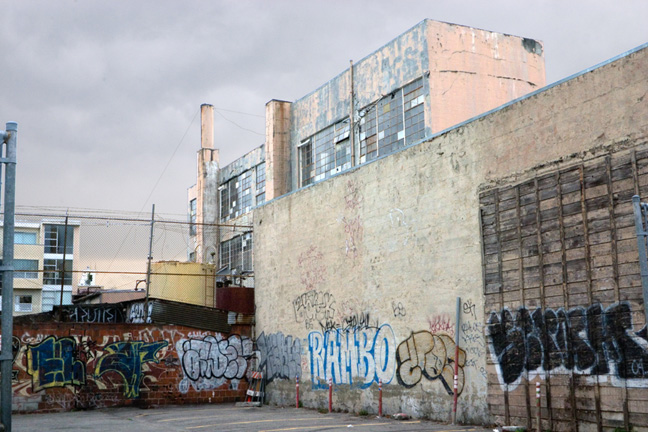
“Dusk – Harriet Street” (2006)
The raw, post-industrial atmosphere depicted here has regrettably almost completely vanished from the South of Market landscape. Many of the old factories and warehouses were torn down during the dot-com boom of the ’90s, to be replaced by gauche live/work lofts and oppressive condominiums that have effaced much of the district’s industrial and working-class history.

Source: California State Library
Sixth and Mission, 1910. Both the five story industrial lofts and the rooming house over storefronts on the corner are still standing today, although the corner building has been stripped and so altered that it is nearly unrecognizable. Partly visible near the upper left above Jessie Street is the Hillsdale Hotel.
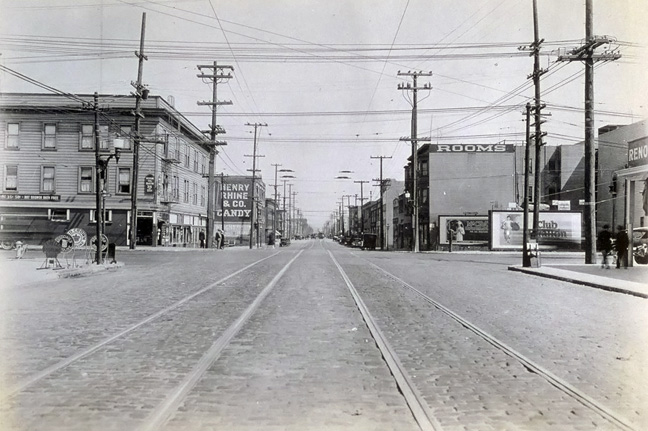
Source: Bancroft Library, Jesse B. Cooke Collection
Sixth and Folsom, 1926. All of the rooming houses and light industrial buildings pictured here have been demolished.
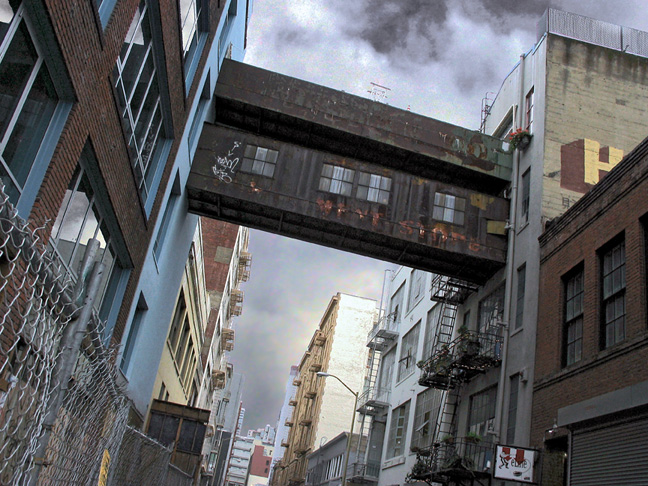
“Inner City (Homage to Chester Gould)” (2003)
Spanning Stevenson Street midway between Sixth and Seventh, a covered footbridge connects what used to be Weinstein’s Department Store and the building that served as that company’s office and warehouse space. The department store has been converted into live/work lofts and the onetime warehouse is now occupied by a dot-com enterprise. I remember when such footbridges were numerous in the back streets of San Francisco not so very long ago. This is the only one that now remains in the central city.
Chester Gould was the artist who for many years drew Dick Tracy, one of my favorite comic strips when I was a boy. I loved the way he drew urban settings. They were always ominous and foreboding, and the buildings had a tendency to lean inward over the streets, making people appear small and insignificant. His later drawings owed a certain debt to film noir, I think, and I owe a debt to his memory for inspiring this picture.
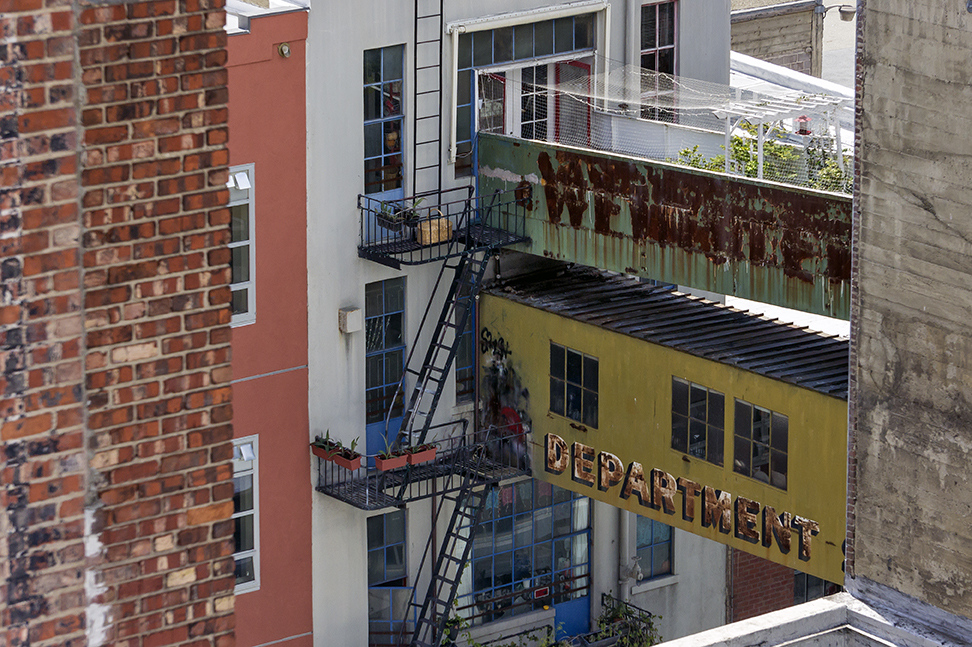
“Above Stevenson” (2014)
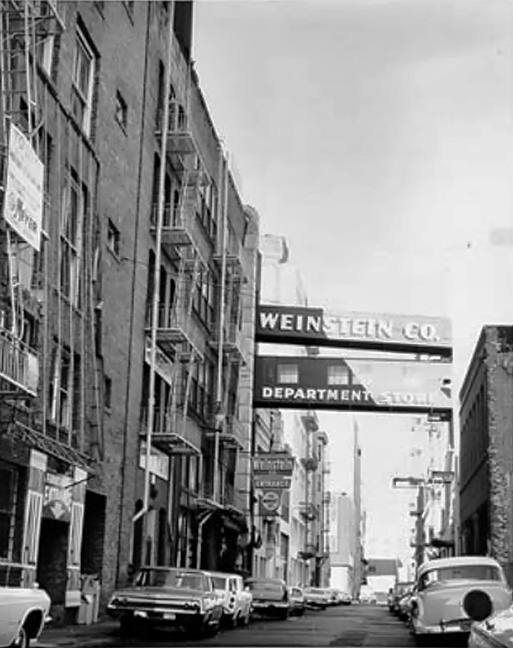
Source: San Francisco History Center, SF Public Library (Photo: Larry Moon)
Stevenson Street, circa 1959.
“Stevenson Street” (2013)
A massive influx of Silicon Valley wealth has kicked the transformation of the central city into high gear. Now more than ever, I savor unkempt back streets, knowing full well that the residue of bygone times will soon be painted over and sanitized.
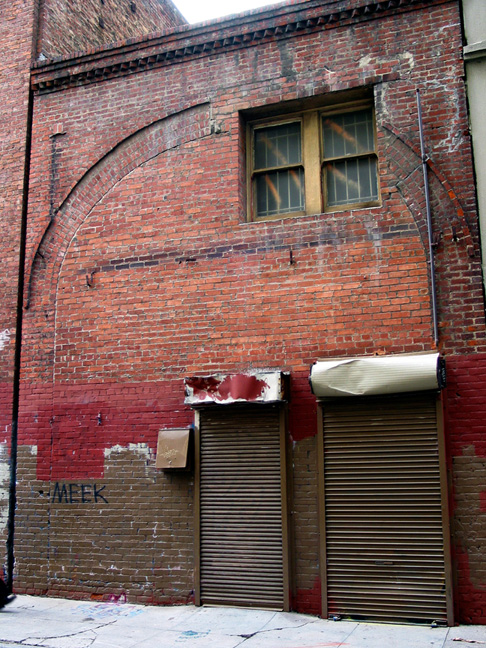
“Imprint of the Past” (2003)
Stevenson Street between Fifth and Sixth.
This building’s architectural heritage is revealed by an archway, though its opening was long-ago filled in. The design and complexity of the original brickwork hearken back a hundred years, to a time when horses were still in common use.
“Reliable” (2012)
Painted at different times over the past century, these beautiful, old ghost signs are on the back of the Hotel Haveli at Sixth and Stevenson.

“Back Street Transfiguration” (2003)
Fascination (trade entrance). Stevenson Street.
The day I photographed Fascination’s service entrance promised to be beautiful and sunny. I savored the early morning quiet as the fog began to burn away with the rising of the sun, exposing more blue sky by the minute and signaling the impending demise of the dawn’s pink light. Of the many photos I took, these two captured the magic of Aurora’s brush. (see also “Fascination” in Part II: Mid-Market).
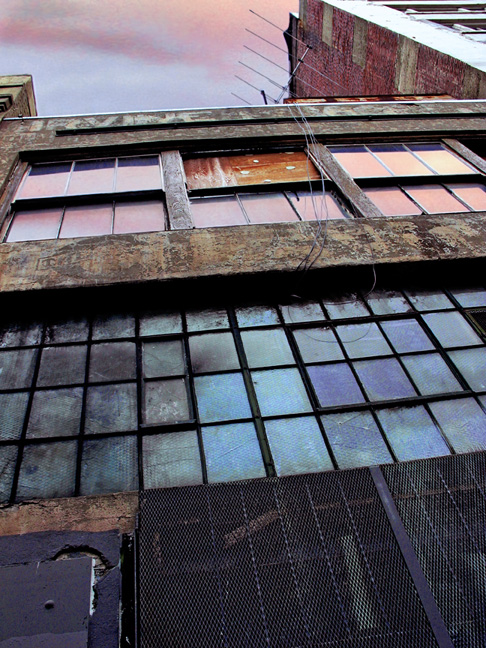
“Daybreak” (2003)
Fascination (trade entrance). Stevenson Street.
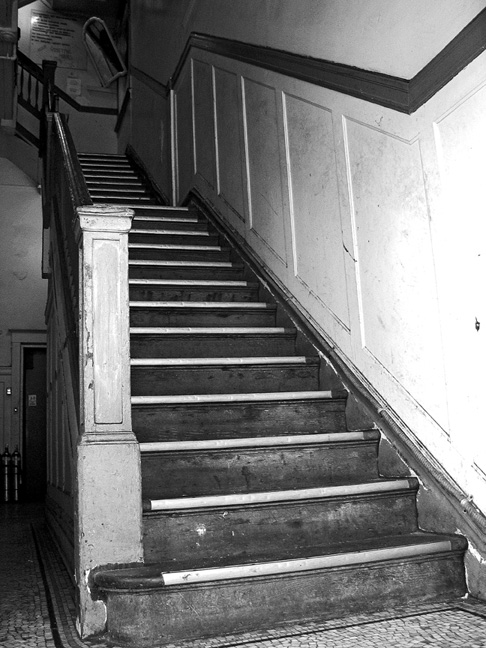
“Stairway to Sunnyside” (2003)
Hotel Sunnyside. 135 Sixth Street.
Residential hotel interiors are not easy to photograph. In general, the managers of SROs are strongly, sometimes violently, opposed to any public exposure of themselves or their buildings. This forbidding stairway leads to the rooms in the Sunnyside Hotel, a place where ghosts linger in dark corners and on the landings.
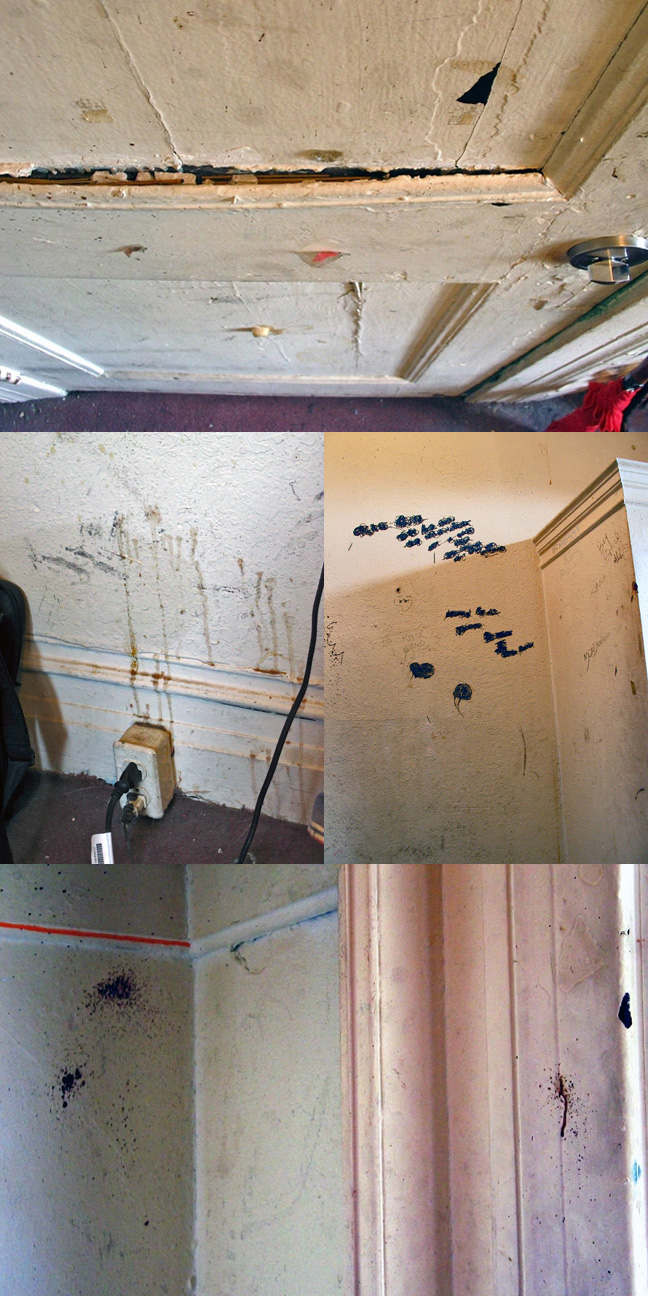
Room 210, Hotel Sunnyside. 135 Sixth Street. (2004)
The conditions shown here are these days fairly typical of the profit-driven Sixth Street hotels. Though a few are much better, there are some that are far worse. Monthly rent in 2010 for an equivalent room is typically in the neighborhood of 700 dollars. In case you are wondering, the dark-brown splashes on the walls are blood.

Room 302, Desmond Hotel. 42 Sixth Street. (2005)
Early in 2005 I was contacted by a tenant at the Desmond Hotel because the manager had refused to either make his room livable or give him another room. The tenant wanted photographic documentation for legal purposes. Happy to be of assistance, I later met him in his room, which the Departments of Building Inspection and Public Health had each given a “pass.”
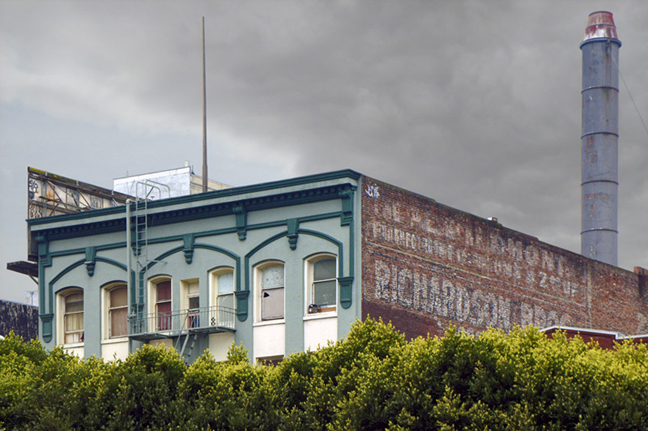
“Alkain” (2012)
Alkain Hotel. 948 Mission Street.
Viewed from Mary Street, the hotel facade and ghost sign make a lovely picture.
“Red Window” (2003)
Alkain Hotel. 948 Mission Street.
As seen from Jessie Street, the rear of the hotel betrays the living conditions inside. Legend has it that the back streets in this area were named for some of the prostitutes who were popular in the days of the Gold Rush, but though in their own way charming, such stories are apocryphal. Jessie Street, for example, was named for the wife of nineteenth-century explorer and California politician John C. Fremont.
“Construction Site – Jessie Street” (2013)
Sad to say, this new building will eclipse the ghost sign on the side of the Alkain Hotel. So many historical signs in this neighborhood have been covered up or lost forever, I only wish I had started documenting the area ten or twenty years earlier. Such is the curse of hindsight.
“Alphabetic Cornice” (2013)
450 Jessie Street.
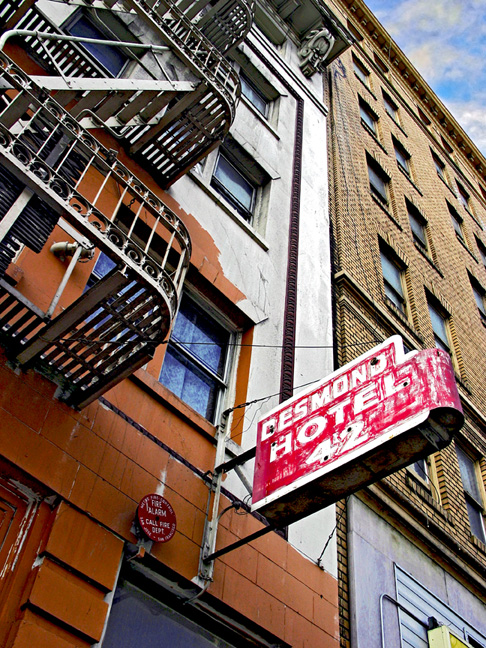
“Desmond” (2003)
Desmond Hotel. 42 Sixth Street.
Having been consigned to History’s dustbin in the name of alleged improvement, most of Sixth Street’s old blade signs have disappeared, to be replaced by cheap canvas awnings and marquees. Gone is the sign for the Desmond Hotel, and the canvas marquee that replaced it is already faded and damaged.
“Sunset – the Alder” (2004)
Alder Hotel. 175 Sixth Street.
Of the few blade signs that remain, the Alder Hotel’s is the finest. It was restored when the hotel was refurbished in 2006.

“Dawn – the Alder” (2006)
Alder Hotel. 175 Sixth Street.
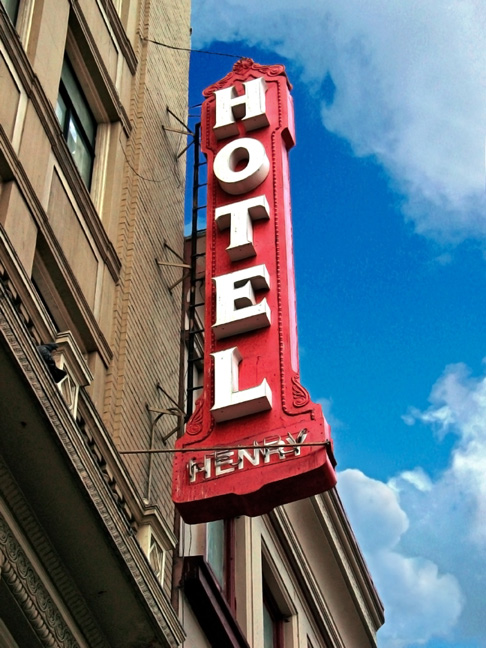
“Henry” (2004)
Hotel Henry. 106 Sixth Street.
Though not restored, the Henry’s blade sign is still in good repair.

“Lawrence” (2003)
Lawrence Hotel. 48 Sixth Street.
With this photograph, my commitment to this project began. Shortly after I captured this image, the sign for the Lawrence Hotel became landfill. The old Desmond Hotel sign, taken down a year later, is partly visible behind the coarsely made-over barber shop sign (for its former appearance, refer to the next photo).

Signs on Sixth Street, 1995. All but three of the blade signs pictured here have been removed. Among those that remain, the barber shop sign has been ruined. (Photo by Virginia Allyn.)
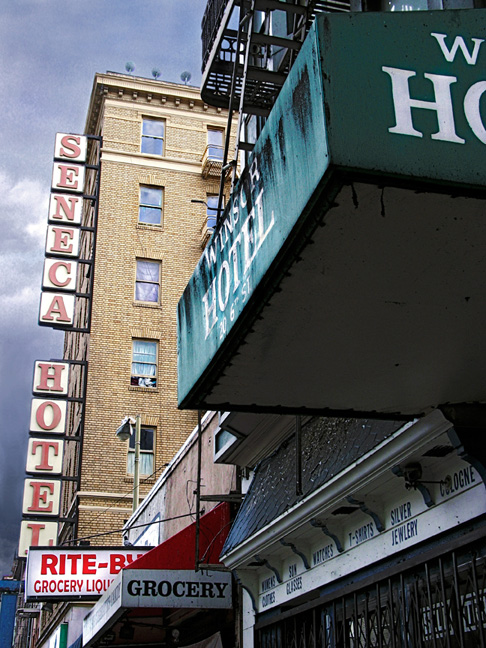
“Upper Sixth Street” (2003)
Seneca Hotel. 34 Sixth Street.
Winsor Hotel. 20 Sixth Street.
For many decades, Grady’s was a popular bar that opened into the lobby of the Seneca Hotel. While its run-down appearance in more recent years may have qualified it as a dive, it was in fact an important social hub for the neighborhood’s older residents, serving as living room and even dining room for people whose homes consisted of a single small room. After the Seneca became a master lease hotel and management was taken over by the Tenderloin Housing Clinic, Grady’s was served with a three-day eviction notice. It closed its doors for the last time on St. Patrick’s Day 2002, leaving many of the community’s seniors without a place where they could meet and socialize. Since then, nothing has been done to address that need. Their social lives erased, it is as if these people never existed. They are rarely, if ever, seen anymore. All that is left for them is the solitude of their lonely rooms.

Grady’s and Club Charleston, 1995. (Photo by Virginia Allyn.)
“Arrow” (2004)
The Arrow. 18 Sixth Street.
Less than a year before I captured this image, the Charleston was a neighborhood gathering spot, a place to socialize for people who live in the area’s hotels. Near the end of 2002, the proprietors sold their liquor license to some young entrepreneurs, and the Charleston became the Arrow, which became the Matador in 2007 and is now in 2010 the Show Down. Within a year of the Charleston’s closing, every other bar on Sixth Street had closed to be later reopened with new names, catering to a very different clientele. My friend Jim Ayers, a resident of Sixth Street since the mid-90s and manager of Grady’s until it closed, kindly helped the Charleston’s new owners get started. For a couple of years he worked the opening shift, and I would drop in for a pint now and then while he was working. One of those times I took some photographs of the bar and this one is my favorite.

Source: San Francisco Chronicle
When a fourth of the City’s power was knocked out for several days by a Mission Street substation explosion in 2003, Jim fired up his portable generator at the Arrow, tuned in the 49ers game, and grilled steaks for patrons on his barbecue, making the Arrow the only place for miles around that was open for business. In this Chronicle Sports Section front-page photo, Jim was actually bemoaning a 49ers touchdown—not the other way around as the caption would have you believe.
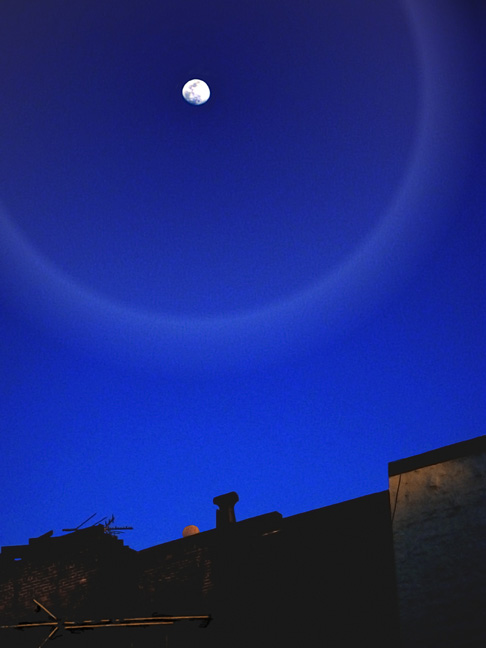
“Moon over Sixth Street” (2004)
Hillsdale Hotel. 61 Sixth Street.
On a cloudless April evening in 2004, I stood in front of the Arrow, talking to Jim. The sun was setting as we talked, and as the sky grew darker I saw that I could capture the waxing moon just as the sun disappeared below the horizon. What appeals to me about this image is its simplicity: just the dark roof line of the Hillsdale, faintly highlighted by the last red rays of sunlight, and the moon in a clear, ultramarine sky.
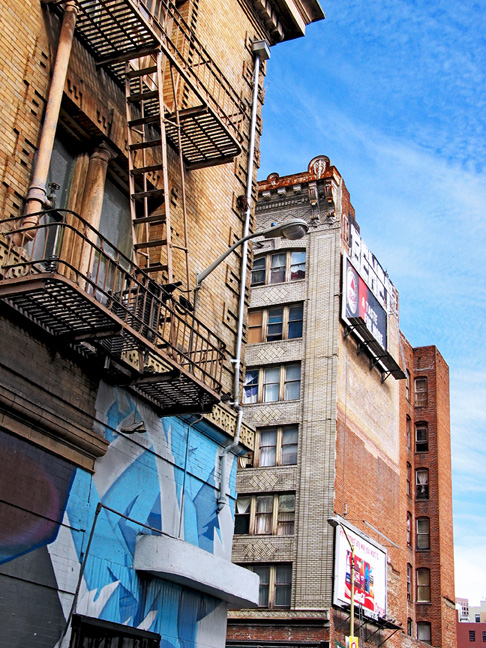
“Reflection” (2003)
Lawrence Hotel. 48 Sixth Street.
Hillsdale Hotel. 51 Sixth Street.
After Angel Cruz was barred from associating with any NASD* member in any capacity for his stock market shenanigans, he used his ill-gotten gains to open Club Six on the ground floor of the Lawrence Hotel. A decades-old neighborhood bar called Frisco was transformed by Cruz into a loud and trendy nightclub, patronized by rowdy hipsters and suburban gangsters getting their kicks by slumming on Sixth Street. Frisco was an affectionate way of referring to the home port used by the merchant marines who once populated Sixth Street’s SROs. It was a name I loved for its in-your-face appeal to the bar’s clientele. Alas, that pride of place has all but entirely vanished, having been replaced by the ethos of the disaffected and the morés of the culture of greed.
*the National Association of Securities Dealers, now part of the Financial Industry Regulatory Authority.
The Street

“Sixth Street Hotels” (2014)
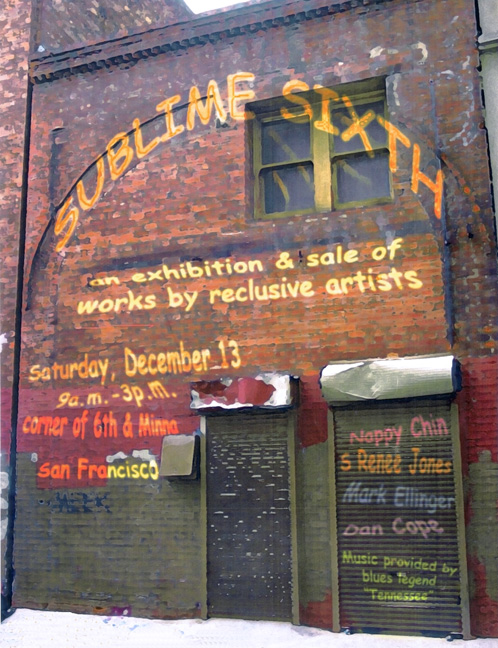
“Sublime Sixth” poster, 2003.
Around ten months after I began photographing my surroundings, I had a group show with two of the founding members of the Sixth Street Photography Workshop, Nappy Chin and S. Renee Jones, and a former resident of the Auburn Hotel, Dan Cope.
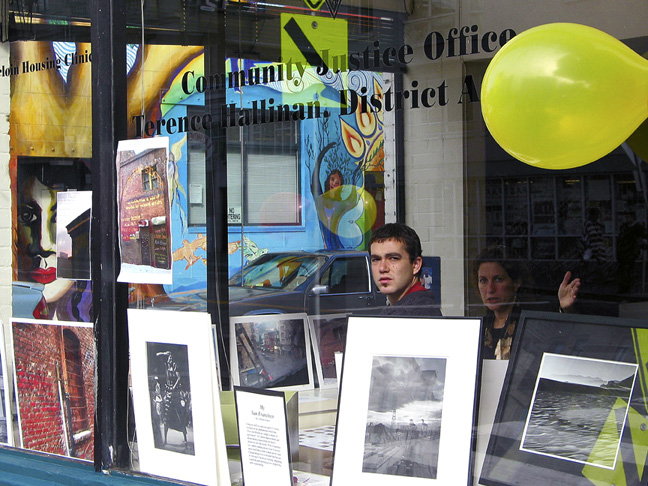
“Sublime Sixth” exhibit, December 2003. An unidentified visitor and Joann Babiak inside the Community Justice Office at Sixth and Minna.
The exhibit was in DA Terrance Hallinan’s Community Justice Office, run by Joann Babiak, an Assistant District Attorney and one of the founders of Positively Sixth Street, a community fair that sadly ended seven years after it was begun.
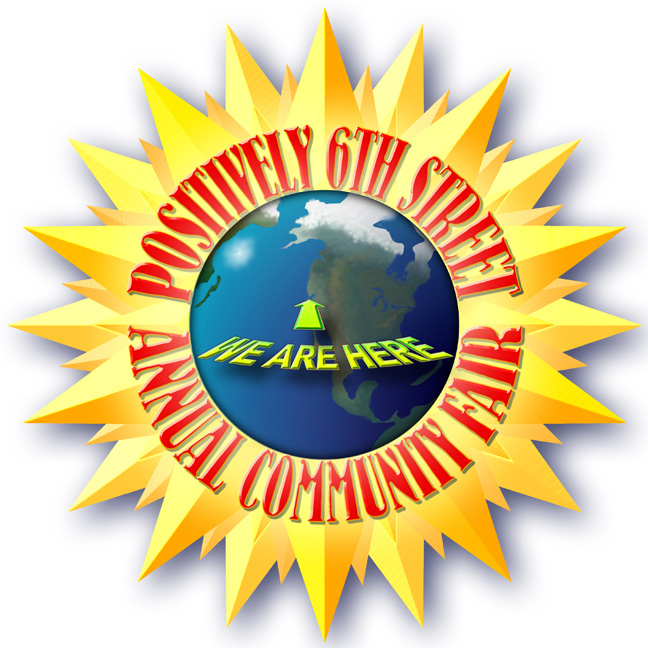
Positively Sixth Street logo. (2004) Designing the graphics for the Sixth Street community fair was pure pleasure. It was an opportunity to create a unique identity that would instill a sense of community pride for people who have long been disenfranchised.
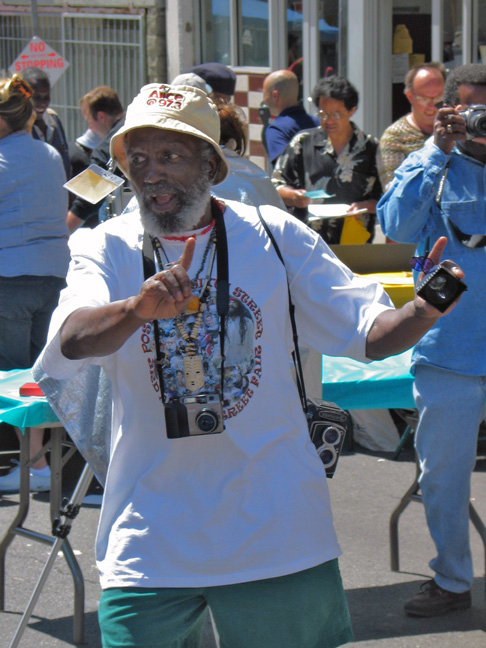
Positively Sixth Street Community Fair, 2004. Nappy Chin sets up a group portrait of the fair’s volunteers.
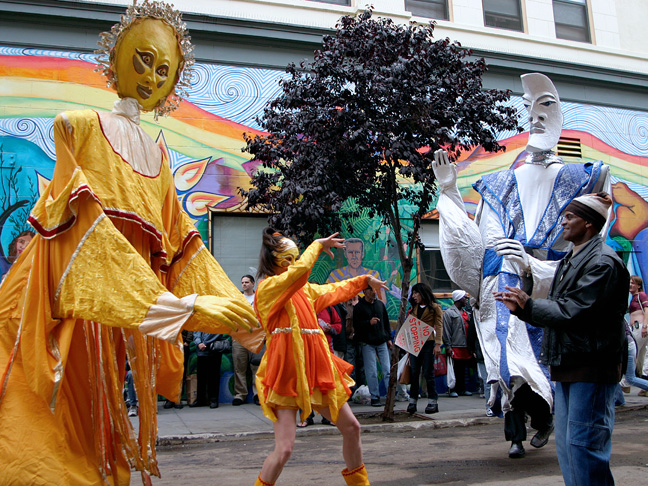
Positively Sixth Street, 2005. A fair-goer dances with the Sun and Moon Ensemble that graced the fair several years.
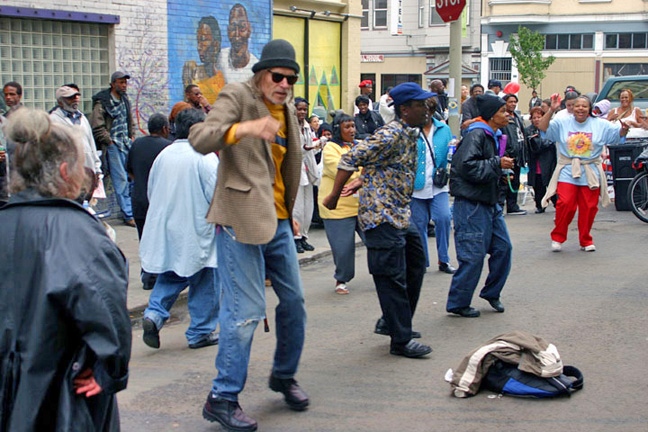
Positively Sixth Street, 2006. Sixth Street residents rock to the music of Bobby Webb, a perennial favorite among the fair’s headliners.
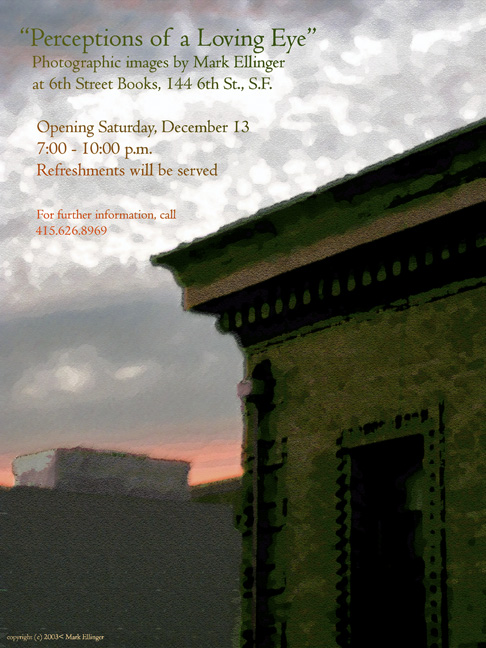
“Perceptions” poster, 2003.
One of my earliest photographs, the Lawrence Hotel at sunset became the poster for my first solo exhibit—on Sixth Street, of course.

“Fire Escape” (2003)
Looking across Jessie Street from my fire escape, I could see the Seneca Hotel behind the Lawrence, and the McAllister Tower in the distance. In the time I lived at the Shree Ganeshai Hotel, I had a very close relationship with that fire escape.
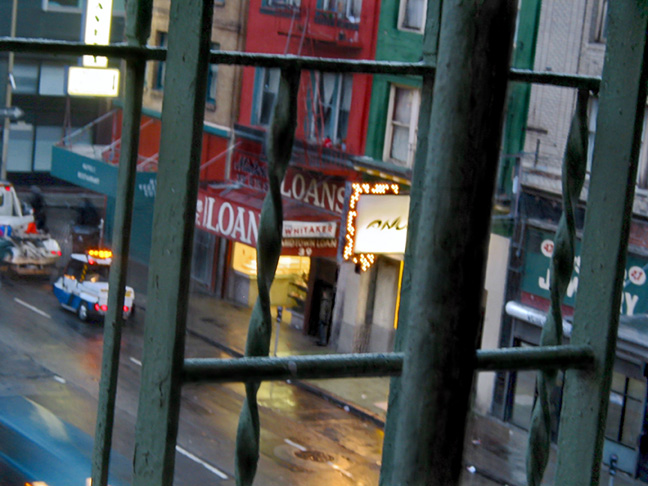
“Rainy Sixth Street #1” (2003)
This photo of a wet evening in late autumn is for me a living image. I hear the sounds of traffic on wet pavement, footfalls on the sidewalks, and the faint staccato of light rainfall. The traffic whizzes by in a darkening world that feels so comforting, as though Mother Earth and the City were tucking me in for the night.

“Rainy Sixth Street #2” (2004)
On a wet December evening the following year, I captured this little scene going down in front of what was once another neighborhood gathering place, Ginger’s Too.

Pawnshops and Ginger’s Too, 1995. (Photo by Virginia Allyn.)

“Window Onto Sixth Street” (2003)
For all its problems, Sixth Street has an unquenchable vitality. The day may be cold and rainy or warm and sunny, but the activity on the street remains constant. The weather was wet and blustery when I took this photograph. I liked the way grime and soot, which for decades had accumulated on the window, imparted the look of a watercolor to the street scene below.
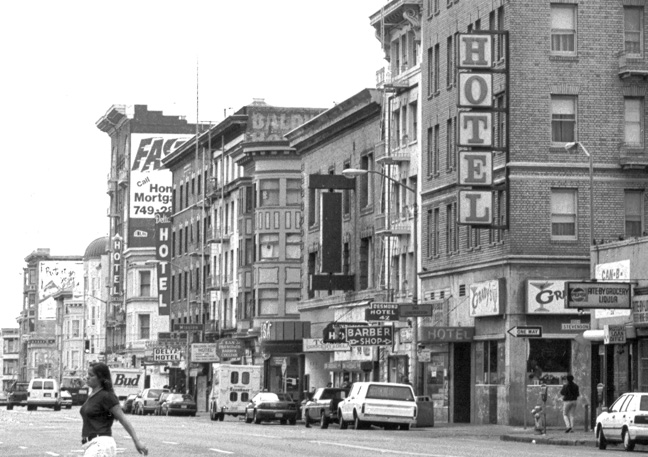
Sixth and Stevenson, 1995. (Photo by Virginia Allyn.)
The redevelopment agency’s Sixth Street Beautification Program widened the sidewalks, installed new street lights, planted ten-thousand-dollar palm trees around the Sixth Street intersections of Mission and Howard, and hung banners from the new street lights that proclaimed Sixth Street was being beautified.

“Sixth and Stevenson” (2010)
While the area’s appearance has slightly improved, Sixth Street remains a containment zone for crime and thus little else has changed. Neighborhood problems continue unabated and the voices and needs of its residents — young and old alike — are still ignored. Whatever you think or would like to believe, there is in fact but one reason for this: they are poor.
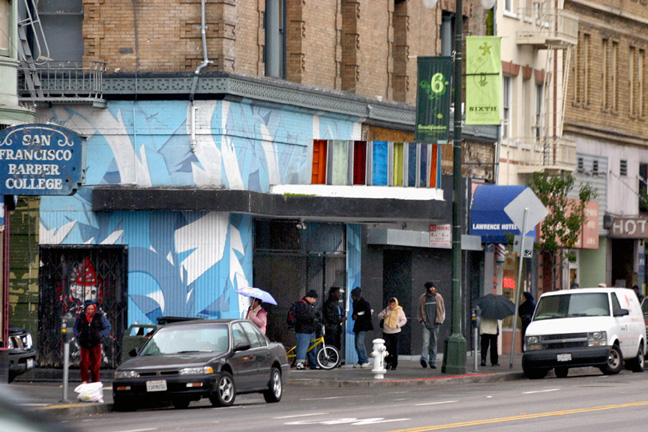
“Club Six” (2006)

“Sixth and Jessie” (2006)
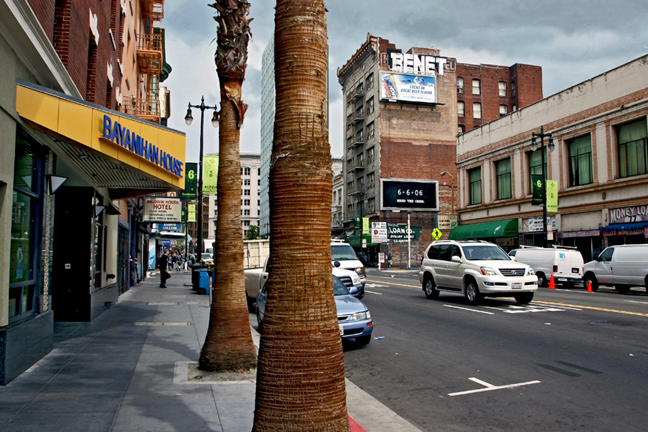
“Sixth and Mission” (2007)
“Sixth and Minna” (2011)

“Sixth below Minna” (2007)
“Sixth and Natoma” (2011)

“Sixth below Natoma” 2007)
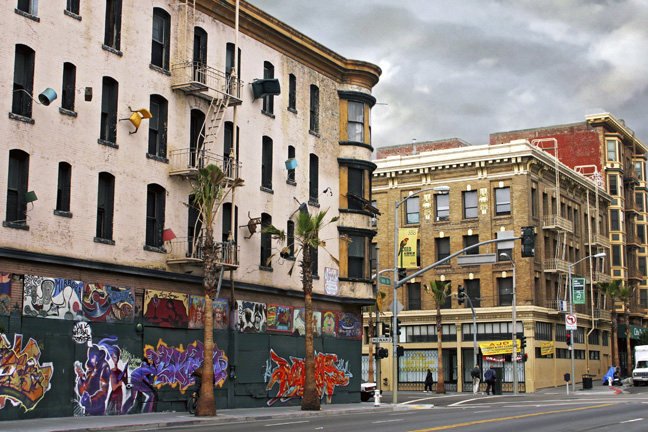
“Sixth and Howard” (2005)
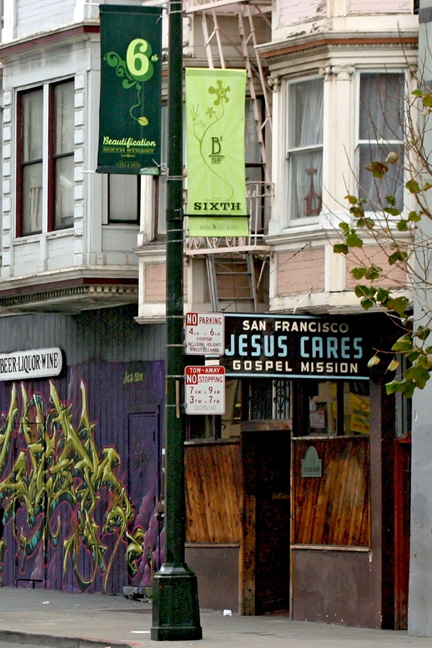
“Beer, Liquor, Wine – Jesus Cares” (2006)
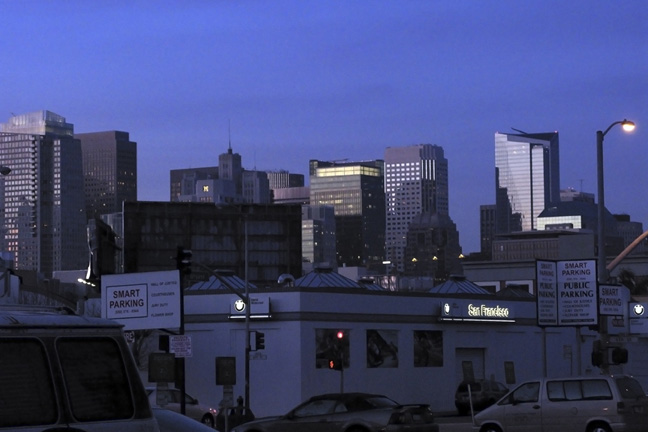
“Twilight Skyline – Sixth and Bryant” (2008)
As seen from the bottom of Sixth Street, the Manhattanization of downtown San Francisco has almost entirely obscured the beautiful Beaux-Arts architecture that once defined its skyline. Soon; very soon, the ground swell of urbanization will wash over Sixth Street and expunge a small and long-overlooked yet nonetheless significant part of San Francisco. For several years now, the transformation of the central city has been marked by an influx of wealthy, young software firms and the so-called creative class of makers and entrepreneurs, a corresponding boom in the development of expensive, high-density highrise housing, Ellis Act evictions, skyrocketing rental prices, and an overall decrease in available low-income housing. Young and affluent neighborhood newcomers are setting their own agenda for change and Sixth Street is now clearly in their sights. It may not happen tomorrow or even next year, but eventually after all is said and done, the existing community will be uprooted and dispersed simply because whoever has the gold makes the rules.
The People
In the time I lived on Sixth Street, many people’s paths crossed mine. To complete my portrait of Sixth Street, I offer sketches of a few of the more memorable characters I encountered. Each person in the following stories has added depth and meaning to my life. They have each in their own way inspired me. Through them shines the soul of Sixth Street.
Still Bill
The sun had disappeared behind a shroud of fog that scudded by in great swirling drifts, like the sails of a phantom armada. What had been a warm day was quickly becoming cold. Sixth Street between Market and Howard was all noise and hubbub. The roar of sirens and rush-hour traffic assaulted my ears. Not to be outdone, the Hydra’s voice of inner-city street life roared even louder. Shouts, cries and raucous laughter punctuated a thousand simultaneous conversations. I was glad to finally reach Howard Street, for there the chaos subsided and the sidewalks were empty. As I walked past the rotting hulk of the Hugo Hotel, I overtook a lone pedestrian, a man with a cane, burdened by a backpack and a duffel bag. Moments later, from behind me he cried out, “Hello? Hello?”

The man sounded desperate, so I retraced my steps to see if I could help. Even from a distance I could see he was troubled. I saw it in the lines of his dark-brown face and in his eyes, but when I stood before him, he seemed hesitant. He tested the water by asking me how I was feeling. Then, encouraged by my friendly response, he said, “I’m still Bill.”
Whether that meant his name was Still Bill or that he remained Bill, I couldn’t tell, so I just asked, “Still Bill?”
Bill’s response left me speechless. As he spoke, I memorized his words.
“I’m still Bill, always was, always will.
“Had a wife named Lucille,
“Had a home down in Mobile.
“Come the war in Vietnam,
“They sent me off and made me kill.
“Come back a broke-up man,
“Weren’t no more home, no more Lucille.
“She’d gone and left me, but I’m still Bill.”
What could I say to that? I told Bill his poetry was beautiful and reminded me of the Blues. Also, I was in shirtsleeves and the damp wind was giving me a chill. How could I help him? It turned out Bill had become lost trying to find a nearby shelter someone had told him about. I said I would show him the way, offering to carry his bag as we walked.
Once in motion, Bill lurched and wobbled, forcing us to stop several times as I helped him regain his balance. The poisonous fumes of cheap, fortified wine hung in the air around him. Fearing he would stumble into the path of a speeding car, I put his arm through mine when we crossed the street. I had to fight back tears when Bill expressed gratitude, he deserved so much more than I could give him. As we drew near the entrance at the back of the municipal shelter, an old industrial building at Fifth and Bryant, I asked Bill if I could photograph him. The only other person in sight was a Native American woman walking toward us along Fifth Street. Though a stranger to both Bill and me, she soon blithely joined us.
A private moment was instantly broken, but strangely I felt no remorse or resentment. Just to behold this woman was to like her. The light of kindness shined in her eyes. Her smiling countenance was open and serene. She was thickset and earthy, yet her hands were slender and sensitive and she moved with the suppleness and grace of a dancer. Seeing that she was curious, I explained I was photographing Bill to commemorate our encounter. When I suggested that I could also photograph her, she went straight to Bill’s side and gently put her arm around his shoulders.
Tbis was too much for Bill, who was suddenly nervous and fidgety, his shy smile replaced by a self-conscious grimace. I had to distract him, so I played the fool while I shot numerous frames to capture him in an unguarded moment. Manifest in every photograph I took are the woman’s radiance and warmth and her compassion for Bill. Before I departed, she told me she would look after Bill inside the shelter. Knowing what I do of shelters and the way they are operated, her words in retrospect seem naively optimistic, but when she spoke, I believed her with all my heart.
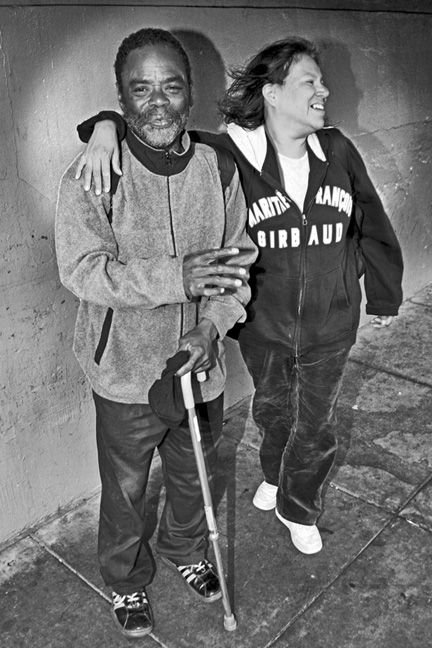
I don’t know her name. For all I know she doesn’t have one. I never thought to ask and probably would have forgotten it anyway, because most names in and of themselves are largely meaningless. We remember people by their actions. I will always remember her for the light and love she shared with Bill and me that cold and foggy afternoon, on a lonely, windblown sidewalk south of Market.
In Praise of a Hero
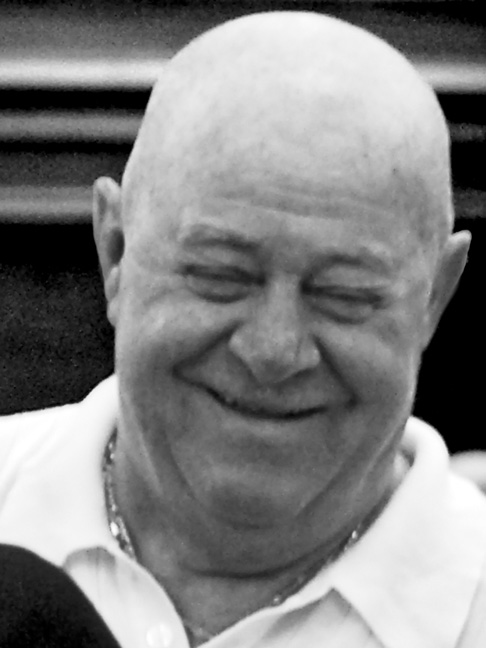
I could talk for a long time about Jim Ayers. His life story is not just remarkable, it is truly inspiring, like a tale written by John Steinbeck or Mark Twain. HL Mencken would have loved him. As I have only two minutes to speak, I’ll give you instead the simple, unadorned reasons that Jim is so highly deserving of this award, which I am enormously pleased to be presenting to him.*
Integrity: Jim is the living, breathing definition. He is, without question, the most trusted person in his community. Jim may be a man of few words, but you can be certain that what he says will always be the truth. Blunt, gruff and unpolished, Jim is also one of the most lovable persons I have ever known, and he has a heart to match. A more compassionate man you will not find. Best of all, Jim shares these virtues with his community.
During the eleven years that he worked there, Jim made Grady’s a comfortable and safe haven for the many seniors who live on Sixth Street. It was, in fact, the only place in the neighborhood where they could escape from their lonely, cramped hotel rooms to socialize, have their morning coffee and read the paper. For Jim, tending bar was entirely secondary to providing for the social needs of Sixth Street’s seniors.
Jim has fought tirelessly and single-handedly for the rights and welfare of the tenants of the Lawrence Hotel, where he has lived for the past fourteen years. After years of thankless, solitary struggle at City Hall and in court, and in the face of intimidation, property damage and physical threats, Jim is winning the battle to force Club Six, the bane of Sixth Street residents since it opened, to comply with noise and public nuisance laws. No one has done more for his community than Jim Ayers, a man I am proud to call my friend.
*The text is a speech I gave when presenting Jim with a Community Leadership Award in May 2007. Regarding the photograph, Jim hates having his picture taken, so he’ll make faces or look away if he’s aware of the camera. In order to catch Jim off-guard, I photographed him through a crowd of people from across the Board of Supervisors chambers at City Hall, hence the grainy and tightly cropped image.
Remembering Jeoflin
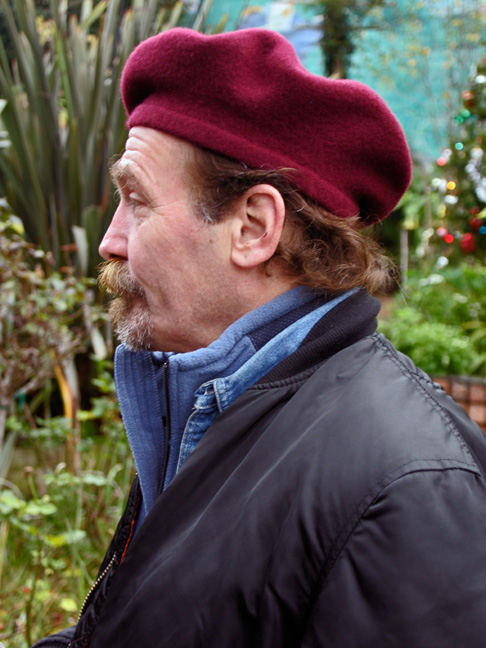
Jeoflin Roh was a founding member of the Central City Restorative Justice Project, the Central City SRO Collaborative, and the Positively 6th Street Community Fair. Dedicated to improving his community, Jeoflin had “been there and back.” I know, because for seven years he was also my friend. Jeoflin was fifty-seven when a brain tumor claimed his life in midsummer 2008.
My initial encounter with Jeoflin was at the original Turk Street office of the Central City SRO Collaborative, when it was still a fledgling organization. It was my first visit there and the only person around was Jeoflin, who was sitting in the sunshine just outside the open back door, smoking a hand-rolled cigarette and reading a book. Jeoflin’s picturesque appearance was his trademark. What caught my eye that day were his distinctive mustache and goatee, his lurid Hawaiian shirt, and the huaraches and Panama hat he wore on sunny days. What won me over were his warmth and sincerity, his wittiness, and his quaintly eccentric demeanor. It was very easy for me to like Jeoflin.
As things turned out, Jeoflin was with me when I first uploaded my photos from the castoff plastic camera with which I began shooting Up From The Deep. I was appalled by the small and muddy-looking images, but Jeoflin ignored the toy-camera flaws and saw only my subject matter and framing. His enthusiasm kept me from tossing that little camera into the nearest wastebasket, and even now I find encouragement when I think of the ardent appreciation for my work that he expressed up to the very end. Thus Jeoflin lives on in my memory. Now, through my photos and words of remembrance, he will live on when I am gone.
A Couplet for Jeoflin
To live without fear of death, life to its fullest,
Is to live each moment as though it were our last.
Thus did Jeoflin and so may we all.
Except where otherwise indicated, text and photos on this site are copyright © 2004-2015, Mark Ellinger. Any use and/or duplication of this material without prior written permission from the author is prohibited. Excerpts and links may be used, provided that full and clear credit is given to Mark Ellinger and with appropriate and specific direction to the original content.

